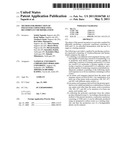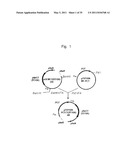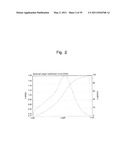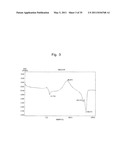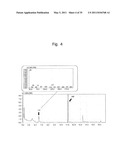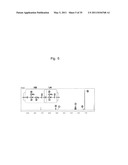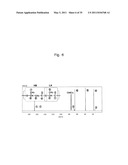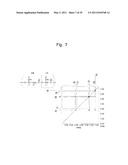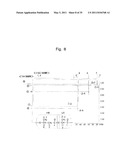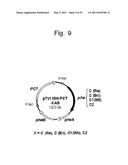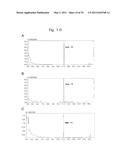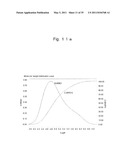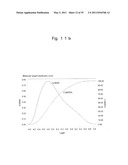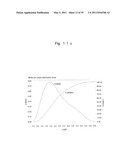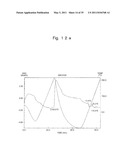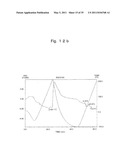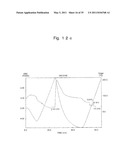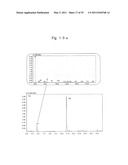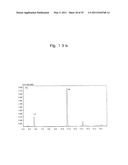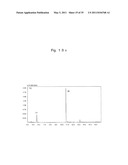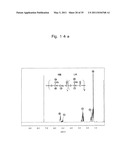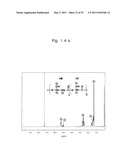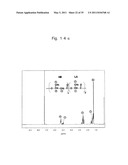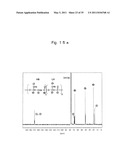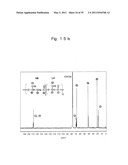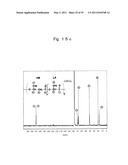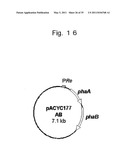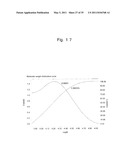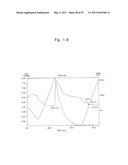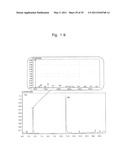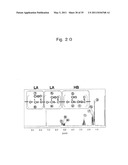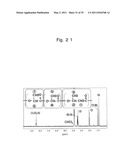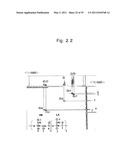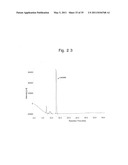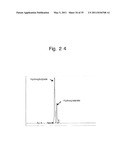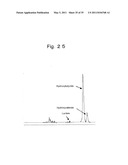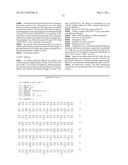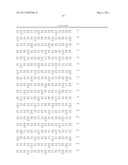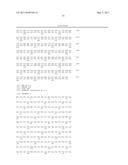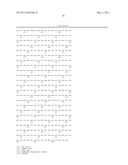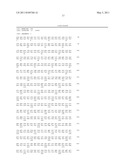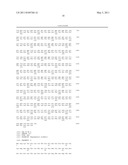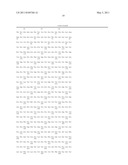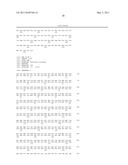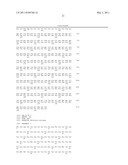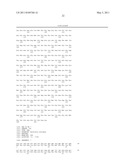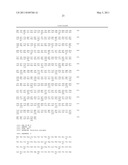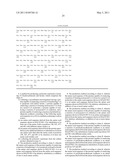Patent application title: METHOD FOR PRODUCTION OF POLYESTER COPOLYMER USING RECOMBINANT MICROORGANISM
Inventors:
Seiichi Taguchi (Sapporo-Shi, JP)
Kenji Tajima (Sapporo-Shi, JP)
Yasuharu Satoh (Sapporo-Shi, JP)
Ken'Ichiro Matsumoto (Sapporo-Shi, JP)
Miwa Yamada (Sapporo-Shi, JP)
Shusei Obata (Nagoya-Shi, JP)
Shusei Obata (Nagoya-Shi, JP)
Hiromi Kambe (Seto-Shi, JP)
Katsuhiro Kohda (Aichi-Gun, JP)
Katsuhiro Ohno (Aichi-Gun, JP)
Takashi Shimamura (Aichi-Gun, JP)
Assignees:
National University Corporation Hokkaido University
TOYOTA JIDOSHA KABUSHIKI KAISHA
IPC8 Class: AC12P762FI
USPC Class:
435135
Class name: Micro-organism, tissue cell culture or enzyme using process to synthesize a desired chemical compound or composition preparing oxygen-containing organic compound carboxylic acid ester
Publication date: 2011-05-05
Patent application number: 20110104768
Claims:
1. A method for producing a polyester copolymer consisting of
3-hydroxybutyrate and lactate, which comprises the steps of: (1)
culturing a recombinant microorganism having a protein capable of
catalyzing a reaction of transferring CoA to propionic acid and/or
lactate, a protein capable of catalyzing a reaction of forming
acetoacetyl-CoA from two acetyl-CoA molecules, a protein capable of
catalyzing a reaction of acetoacetyl-CoA reduction, and a protein capable
of catalyzing a reaction of polyhydroxyalkanoate synthesis consisting of
the following amino acid sequence (a) or (b) in a medium containing a
carbon source: (a) an amino acid sequence derived from the amino acid
sequence shown in SEQ ID NO: 2 by substitution of at least one of the
amino acids at positions 130, 325, 477, and 481 with different amino
acid(s); or (b) an amino acid sequence derived from the protein specified
in (a) by additional deletion or substitution of at least one amino acid
other than the amino acids at positions 130, 325, 477, and 481 or by
insertion of at least one amino acid residue; and (2) collecting the
polyester copolymer from the culture product obtained in step (1).
2. The production method according to claim 1, wherein the amino acid sequence of the protein capable of catalyzing a reaction of transferring CoA to propionic acid and/or lactate is the amino acid sequence shown in SEQ ID NO: 4 or an amino acid sequence derived from the amino acid sequence shown in SEQ ID NO: 4 by deletion, substitution, or addition of one or more amino acid(s).
3. The production method according to claim 1, wherein the amino acid sequence of the protein capable of catalyzing a reaction of forming acetoacetyl-CoA from two acetyl-CoA molecules is the amino acid sequence shown in SEQ ID NO: 6 or an amino acid sequence derived from the amino acid sequence shown in SEQ ID NO: 6 by deletion, substitution, or addition of one or more amino acid(s).
4. The production method according to claim 1, wherein the amino acid sequence of the protein capable of catalyzing a reaction of acetoacetyl-CoA reduction is the amino acid sequence shown in SEQ ID NO: 8 or an amino acid sequence derived from the amino acid sequence shown in SEQ ID NO: 8 by deletion, substitution, or addition of one or more amino acid(s).
5. The production method according to claim 1, wherein the amino acid sequence of the protein capable of catalyzing a reaction of polyhydroxyalkanoate synthesis is an amino acid sequence derived from the amino acid sequence shown in SEQ ID NO: 2 by substitution of amino acids at positions 325 and 481 with different amino acids.
6. The production method according to claim 5, wherein the amino acid sequence of the protein capable of catalyzing a reaction of polyhydroxyalkanoate synthesis is an amino acid sequence derived from the amino acid sequence shown in SEQ ID NO: 2 by simultaneous substitution of amino acids at positions 325 and 481.
7. The production method according to claim 6, wherein the amino acid sequence of the protein capable of catalyzing a reaction of polyhydroxyalkanoate synthesis is an amino acid sequence derived from the amino acid sequence shown in SEQ ID NO: 2 by substitution of Ser at position 325 with Thr and Gln at position 481 with Lys.
8. The production method according to claim 1, wherein any one of the proteins is a protein encoded by a recombinant expression vector introduced into a microorganism.
9. The production method according to claim 1, wherein culture of the recombinant microorganism is carried out under anaerobic conditions.
10. The production method according to claim 1, wherein the microorganism is a microorganism having the ability to accumulate lactate.
11. The production method according to claim 10, wherein the microorganism having a high degree of ability to accumulate lactate is of the Escherichia coli Jw2293, Jw0885, or Jw0886 strain.
12. A method for producing a polyester copolymer consisting of 3-hydroxybutyrate and lactate, which comprises the steps of: (1) culturing a recombinant microorganism having a protein capable of catalyzing a reaction of transferring CoA to propionic acid and/or lactate, a protein capable of catalyzing a reaction of forming acetoacetyl-CoA from two acetyl-CoA molecules, a protein capable of catalyzing a reaction of acetoacetyl-CoA reduction, and a protein capable of catalyzing a reaction of polyhydroxyalkanoate synthesis consisting of the following amino acid sequence (a) or (b) in a medium containing a hydroxyalkanoate other than 3-hydroxybutyrate and lactate and a carbon source: (a) an amino acid sequence derived from the amino acid sequence shown in SEQ ID NO: 2 by substitution of at least one of the amino acids at positions 130, 325, 477, and 481 with different amino acid(s); or (b) an amino acid sequence derived from the protein specified in (a) by additional deletion or substitution of at least one amino acid other than the amino acids at positions 130, 325, 477, and 481 or by insertion of at least one amino acid residue; and (2) collecting the polyester copolymer from the culture product obtained in step (1).
13. The production method according to claim 12, wherein the amino acid sequence of the protein capable of catalyzing a reaction of transferring CoA to propionic acid and/or lactate is the amino acid sequence shown in SEQ ID NO: 4 or an amino acid sequence derived from the amino acid sequence shown in SEQ ID NO: 4 by deletion, substitution, or addition of one or more amino acid(s).
14. The production method according to claim 12, wherein the amino acid sequence of the protein capable of catalyzing a reaction of forming acetoacetyl-CoA from two acetyl-CoA molecules is the amino acid sequence shown in SEQ ID NO: 6 or an amino acid sequence derived from the amino acid sequence shown in SEQ ID NO: 6 by deletion, substitution, or addition of one or more amino acid(s).
15. The production method according to claim 12, wherein the amino acid sequence of the protein capable of catalyzing a reaction of acetoacetyl-CoA reduction is the amino acid sequence shown in SEQ ID NO: 8 or an amino acid sequence derived from the amino acid sequence shown in SEQ ID NO: 8 by deletion, substitution, or addition of one or more amino acid(s).
16. The production method according to claim 12, wherein the amino acid sequence of the protein capable of catalyzing a reaction of polyhydroxyalkanoate synthesis is an amino acid sequence derived from the amino acid sequence shown in SEQ ID NO: 2 by substitution of amino acids at positions 325 and 481 with different amino acids.
17. The production method according to claim 12, wherein the amino acid sequence of the protein capable of catalyzing a reaction of polyhydroxyalkanoate synthesis is an amino acid sequence derived from the amino acid sequence shown in SEQ ID NO: 2 by simultaneous substitution of amino acids at positions 325 and 481.
18. The production method according to claim 16, wherein the amino acid sequence of a protein capable of catalyzing a reaction of polyhydroxyalkanoate synthesis is an amino acid sequence derived from the amino acid sequence shown in SEQ ID NO: 2 by substitution of Ser at position 325 with Thr and Gln at position 481 with Lys.
19. The production method according to claim 12, wherein any one of the proteins is a protein encoded by a recombinant expression vector introduced into a microorganism.
20. The production method according to claim 12, wherein a precursor of the hydroxyalkanoate other than 3-hydroxybutyrate or lactate is at least one precursor selected from the group consisting of propionic acid, valeric acid, dodecanoic acid, 4-hydroxybutanoate, and 4-hydroxyvalerate.
21. The production method according to claim 12, wherein the culture of a recombinant microorganism is carried out under anaerobic conditions.
22. The production method according to claim 12, wherein the microorganism is a microorganism having the ability to accumulate lactate.
23. The production method according to claim 22, wherein the microorganism having a high degree of ability to accumulate lactate is of the Escherichia coli Jw2293, Jw0885, or Jw0886 strain.
24. A recombinant microorganism that expresses a protein capable of catalyzing a reaction of transferring CoA to propionic acid and/or lactate, a protein capable of catalyzing a reaction of forming acetoacetyl-CoA from two acetyl-CoA molecules, a protein capable of catalyzing a reaction of acetoacetyl-CoA reduction, and a protein capable of catalyzing a reaction of polyhydroxyalkanoate synthesis consisting of the following amino acid sequence (a) or (b): (a) an amino acid sequence derived from the amino acid sequence shown in SEQ ID NO: 2 by substitution of at least one of the amino acids at positions 130, 325, 477, and 481 with different amino acid(s); or (b) an amino acid sequence derived from the protein specified in (a) by additional deletion or substitution of at least one amino acid other than the amino acids at positions 130, 325, 477, and 481 or by insertion of at least one amino acid residue.
25. The recombinant microorganism according to claim 24, wherein the amino acid sequence of the protein capable of catalyzing a reaction of transferring CoA to propionic acid and/or lactate is the amino acid sequence shown in SEQ ID NO: 4 or an amino acid sequence derived from the amino acid sequence shown in SEQ ID NO: 4 by deletion, substitution, or addition of one or more amino acid(s).
26. The recombinant microorganism according to claim 24, wherein the amino acid sequence of the protein capable of catalyzing a reaction of forming acetoacetyl-CoA from two acetyl-CoA molecules is the amino acid sequence shown in SEQ ID NO: 6 or an amino acid sequence derived from the amino acid sequence shown in SEQ ID NO: 6 by deletion, substitution, or addition of one or more amino acid(s).
27. The recombinant microorganism according to claim 24, wherein the amino acid sequence of the protein capable of catalyzing a reaction of acetoacetyl-CoA reduction is the amino acid sequence shown in SEQ ID NO: 8 or an amino acid sequence derived from the amino acid sequence shown in SEQ ID NO: 8 by deletion, substitution, or addition of one or more amino acid(s).
28. The recombinant microorganism according to claim 24, wherein the amino acid sequence of the protein capable of catalyzing a reaction of polyhydroxyalkanoate synthesis is an amino acid sequence derived from the amino acid sequence shown in SEQ ID NO: 2 by substitution of amino acids at positions 325 and 481 with different amino acids.
29. The recombinant microorganism according to claim 24, wherein the amino acid sequence of the protein capable of catalyzing a reaction of polyhydroxyalkanoate synthesis is an amino acid sequence derived from the amino acid sequence shown in SEQ ID NO: 2 by simultaneous substitution of amino acids at positions 325 and 481.
30. The recombinant microorganism according to claim 28, wherein the amino acid sequence of a protein capable of catalyzing a reaction of polyhydroxyalkanoate synthesis is an amino acid sequence derived from the amino acid sequence shown in SEQ ID NO: 2 by substitution of Ser at position 325 with Thr and Gln at position 481 with Lys.
31. The recombinant microorganism according to claim 24, wherein any one of the proteins is a protein encoded by a recombinant expression vector introduced into a microorganism.
32. The recombinant microorganism according to claim 24, wherein the microorganism is a microorganism having the ability to accumulate lactate.
33. The recombinant microorganism according to claim 32, wherein the microorganism having a high degree of ability to accumulate lactate is of the Escherichia coli Jw2293, Jw0885, or Jw0886 strain.
Description:
TECHNICAL FIELD
[0001] The present invention relates to a method for producing a polyester copolymer using a recombinant microorganism.
BACKGROUND ART
[0002] Many microorganisms have been reported to have the ability to produce a polyester using a sugar as a carbon source (Non-Patent Document 1). Polyesters produced by microorganisms have been gaining attention as biodegradable plastics that can be readily degraded in nature or as "green" plastics that can be synthesized from renewable carbon resources such as sugars or plant oils.
[0003] A representative example of a biodegradable plastic produced by a microorganism is poly-3-hydroxybutyrate (polyhydoroxybutyrate (PHB)) consisting of 3-hydroxybutyrate (3HB) monomers. PHB is a thermoplastic polymer having a melting temperature of approximately 180° C. PHB has excellent melting processability as well as biodegradability, which is advantageous. At the same time, PHB is hard and fragile because of its high crystallinity. That is to say, it has poor shock resistance, which is problematic in terms of physical properties.
[0004] As a method for solving problems regarding physical properties of PHB, a method for producing a polyester copolymer consisting of 3HB and a different hydroxyalkanoate using a microorganism has been developed.
[0005] For example, Patent Document 1 discloses a method for producing a copolymer consisting of 3HB and 3-hydroxyvalerate (3HV). In addition, Patent Document 2 discloses a method for producing a copolymer consisting of 3HB and 3HV by allowing a microorganism of the genus Methylobacterium (Methylobacterium sp.), Paracoccus (Paracoccus sp.), Alcaligenes (Alcaligenes sp.), or Pseudomonas (Pseudomonas sp.) to come into contact with a primary alcohol having a carbon number of 3 to 7.
[0006] Such copolymer consisting of 3HB and 3HV has a higher degree of flexibility than PHB. In addition, it has been confirmed that an increase in the 3HV content in a polyester copolymer results in enhanced flexibility. In the above method for producing a copolymer consisting of 3HB and 3HV using a microorganism, the 3HV content in a polyester copolymer is regulated by adding, for example, propionic acid in the case of Patent Document 1 or propane-1-ol in the case of Patent Document 3 to a medium.
[0007] For instance, P(3HB-co-3HH), which is a two-component polyester copolymer consisting of 3HB and 3-hydroxyhexanoate (hereinafter abbreviated as "3HH"), and a method for producing the same are disclosed in Patent Documents 4 and 5. In the methods for producing a P(3HB-co-3HH) copolymer disclosed in these Patent Documents, fermentative production from a fatty acid such as oleic acid or fat and oil such as olive oil is carried out using Aeromonas caviae isolated from the soil. In addition, it has been reported that a recombinant strain is obtained by cloning the PHA synthase gene from A. caviae and introducing the cloned gene into Alcaligenes eutrophus for production of P(3HB-co-3HH) with the use of fatty acid as a carbon source and the recombinant strain (Patent Document 6).
[0008] In addition, in any case of the above methods for producing a polyester copolymer using a microorganism, it is necessary to use a polyhydroxyalkanoate synthase, which is an enzyme protein having activity of directly synthesizing a polymer. In addition, it has been attempted to modify such synthase so as to control the monomer unit mole fraction. For example, Patent Document 7 discloses a mutant enzyme capable of producing PHB with a high 3HB content, which is obtained by modifying the amino acid sequence of a polyhydroxyalkanoate synthase of a microorganism that has been identified as Pseudomonas sp. 61-3.
[0009] In the above document, a polyester copolymer consisting of 3-hydroxyalkanoate serving as a monomer unit and a method for producing the same using a microorganism are described. Meanwhile, a polyester copolymer consisting of a non-3-hydroxyalkanoate component serving as a monomer unit is expected to have physical properties differing from those of the above polyester copolymer. Patent Document 8 discloses a method for producing, as an example of such polyester copolymer comprising a non-3-hydroxyalkanoate component serving as a monomer unit, a polyester copolymer consisting of 3HB and lactate (LA) by culturing Ralstonia eutropha (previous name: Alcaligenes eutrophus) incorporating the nucleic acid encoding propionyl-CoA transferase of Clostridium propionicum with the addition of lactate to a medium. The document further discloses a method for producing a copolymer consisting of 3-hydroxyhexanoate, 3-hydroxyoctanoate, 3-hydroxydecanoate, and lactate by culturing Escherichia coli incorporating the nucleic acid encoding C. propionium-derived propionyl-CoA transferase and the nucleic acid encoding Pseudomonas sp. 61-3-derived polyhydroxyalkanoate synthase with addition of lactate and decenoic acid to a medium.
[0010] However, a method for synthesizing polyhydroxyalkanoate with the addition of a monomer component such as lactate or decenoic acid to a medium is disadvantageous in terms of cost of starting materials. Further, in general, the polymer productivity and the carbon source yield become low in the case of production of a polyester copolymer using a microorganism. Therefore, improvement of productivity or yield is an important task for reduction of production cost also in a case in which an inexpensive natural substance or the like is used as a carbon source. [0011] Non-Patent Document 1: "Biodegradable Plastic Handbook," Biodegradable Plastics Society, 1995, pp. 178-197, published by NTS Inc.) [0012] Patent Document 1: JP Patent Publication (Kokai) No. 57-150393 A (1982) [0013] Patent Document 2: JP Patent Publication (Kokai) No. 5-74492 A (1993) [0014] Patent Document 3: JP Patent Publication (Kokoku) No. 7-79705 B (1995) [0015] Patent Document 4: JP Patent Publication (Kokai) No. 5-93049 A (1993) [0016] Patent Document 5: JP Patent Publication (Kokai) No. 7-265065 A (1995) [0017] Patent Document 6: JP Patent Publication (Kokai) No. 10-108682 A (1998) [0018] Patent Document 7: WO2003/100055 [0019] Patent Document 8: WO2006/126796
DISCLOSURE OF THE INVENTION
Problem To Be Solved By the Invention
[0020] It is an object of the present invention to provide a method for efficiently producing a polyester copolymer consisting of 3HB and LA (other than 3-hydroxyalkanoate) serving as a monomer unit via microbial fermentation with the use of a sugar as a starting material. In addition, it is another object of the present invention to provide a method for producing a polyester copolymer containing LA at a different mole fraction by regulating the 3HB mole fraction in a polyester depending on the characteristics of an enzyme to be used, selecting a specific host, or adjusting culture conditions. It is a further object of the present invention to provide a method for efficiently producing a polyester copolymer further comprising a monomer unit other than LA and 3HB via microbial fermentation with the use of a sugar as a starting material.
Means For Solving Problem
[0021] The present inventors found that a recombinant microorganism into which the nucleic acid encoding the polyhydroxyalkanoate synthase mutant disclosed in Patent Document 7 has been introduced can efficiently produce a polyester copolymer consisting of 3HB and LA directly from a sugar, and that the LA mole fraction in the copolymer can be controlled. The present inventors further found that a polyester copolymer further comprising a monomer unit other than LA and 3HB can be efficiently produced by supplying a precursor of the monomer component other than 3HB or LA to a medium. This has led to the completion of the individual inventions described below.
[0022] (1) A method for producing a polyester copolymer consisting of 3-hydroxybutyrate and lactate, which comprises the steps of:
[0023] 1) culturing a recombinant microorganism having a protein capable of catalyzing a reaction of transferring CoA to propionic acid and/or lactate, a protein capable of catalyzing a reaction of forming acetoacetyl-CoA from two acetyl-CoA molecules, a protein capable of catalyzing a reaction of acetoacetyl-CoA reduction, and a protein capable of catalyzing a reaction of polyhydroxyalkanoate synthesis consisting of the following amino acid sequence (a) or (b) in a medium containing a carbon source:
[0024] (a) an amino acid sequence derived from the amino acid sequence shown in SEQ ID NO: 2 by substitution of at least one of the amino acids at positions 130, 325, 477, and 481 with different amino acid(s); or
[0025] (b) an amino acid sequence derived from the protein specified in (a) by additional deletion or substitution of at least one amino acid other than the amino acids at positions 130, 325, 477, and 481 or by insertion of at least one amino acid residue; and
[0026] 2) collecting the polyester copolymer from the culture product obtained in step 1).
[0027] (2) The production method according to (1), wherein the amino acid sequence of the protein capable of catalyzing a reaction of transferring CoA to propionic acid and/or lactate is the amino acid sequence shown in SEQ ID NO: 4 or an amino acid sequence derived from the amino acid sequence shown in SEQ ID NO: 4 by deletion, substitution, or addition of one or more amino acid(s).
[0028] (3) The production method according to (1), wherein the amino acid sequence of the protein capable of catalyzing a reaction of forming acetoacetyl-CoA from two acetyl-CoA molecules is the amino acid sequence shown in SEQ ID NO: 6 or an amino acid sequence derived from the amino acid sequence shown in SEQ ID NO: 6 by deletion, substitution, or addition of one or more amino acid(s).
[0029] (4) The production method according to (1), wherein the amino acid sequence of the protein capable of catalyzing a reaction of acetoacetyl-CoA reduction is the amino acid sequence shown in SEQ ID NO: 8 or an amino acid sequence derived from the amino acid sequence shown in SEQ ID NO: 8 by deletion, substitution, or addition of one or more amino acid(s).
[0030] (5) The production method according to (1), wherein the amino acid sequence of the protein capable of catalyzing a reaction of polyhydroxyalkanoate synthesis is an amino acid sequence derived from the amino acid sequence shown in SEQ ID NO: 2 by substitution of amino acids at positions 325 and 481 with different amino acids.
[0031] (6) The production method according to (5), wherein the amino acid sequence of the protein capable of catalyzing a reaction of polyhydroxyalkanoate synthesis is an amino acid sequence derived from the amino acid sequence shown in SEQ ID NO: 2 by simultaneous substitution of amino acids at positions 325 and 481.
[0032] (7) The production method according to (6), wherein the amino acid sequence of the protein capable of catalyzing a reaction of polyhydroxyalkanoate synthesis is an amino acid sequence derived from the amino acid sequence shown in SEQ ID NO: 2 by substitution of Ser at position 325 with Thr and Gln at position 481 with Lys.
[0033] (8) The production method according to (1), wherein any one of the proteins is a protein encoded by a recombinant expression vector introduced into a microorganism.
[0034] (9) The production method according to any one of (1) to (8), wherein culture of the recombinant microorganism is carried out under anaerobic conditions.
[0035] (10) The production method according to any one of (1) to (9), wherein the microorganism is a microorganism having the ability to accumulate lactate.
[0036] (11) The production method according to (10), wherein the microorganism having a high degree of ability to accumulate lactate is of the Escherichia coli Jw2293, Jw0885, or Jw0886 strain.
[0037] (12) A method for producing a polyester copolymer consisting of 3-hydroxybutyrate and lactate, which comprises the steps of:
[0038] 1) culturing a recombinant microorganism having a protein capable of catalyzing a reaction of transferring CoA to propionic acid and/or lactate, a protein capable of catalyzing a reaction of forming acetoacetyl-CoA from two acetyl-CoA molecules, a protein capable of catalyzing a reaction of acetoacetyl-CoA reduction, and a protein capable of catalyzing a reaction of polyhydroxyalkanoate synthesis consisting of the following amino acid sequence (a) or (b) in a medium containing a hydroxyalkanoate other than 3-hydroxybutyrate and lactate and a carbon source:
[0039] (a) an amino acid sequence derived from the amino acid sequence shown in SEQ ID NO: 2 by substitution of at least one of the amino acids at positions 130, 325, 477, and 481 with different amino acid(s); or
[0040] (b) an amino acid sequence derived from the protein specified in (a) by additional deletion or substitution of at least one amino acid other than the amino acids at positions 130, 325, 477, and 481 or by insertion of at least one amino acid residue; and
[0041] 2) collecting the polyester copolymer from the culture product obtained in step 1).
[0042] (13) The production method according to (12), wherein the amino acid sequence of the protein capable of catalyzing a reaction of transferring CoA to propionic acid and/or lactate is the amino acid sequence shown in SEQ ID NO: 4 or an amino acid sequence derived from the amino acid sequence shown in SEQ ID NO: 4 by deletion, substitution, or addition of one or more amino acid(s).
[0043] (14) The production method according to (12), wherein the amino acid sequence of the protein capable of catalyzing a reaction of forming acetoacetyl-CoA from two acetyl-CoA molecules is the amino acid sequence shown in SEQ ID NO: 6 or an amino acid sequence derived from the amino acid sequence shown in SEQ ID NO: 6 by deletion, substitution, or addition of one or more amino acid(s).
[0044] (15) The production method according to (12), wherein the amino acid sequence of the protein capable of catalyzing a reaction of acetoacetyl-CoA reduction is the amino acid sequence shown in SEQ ID NO: 8 or an amino acid sequence derived from the amino acid sequence shown in SEQ ID NO: 8 by deletion, substitution, or addition of one or more amino acid(s).
[0045] (16) The production method according to (12), wherein the amino acid sequence of the protein capable of catalyzing a reaction of polyhydroxyalkanoate synthesis is an amino acid sequence derived from the amino acid sequence shown in SEQ ID NO: 2 by substitution of amino acids at positions 325 and 481 with different amino acids.
[0046] (17) The production method according to (12), wherein the amino acid sequence of the protein capable of catalyzing a reaction of polyhydroxyalkanoate synthesis is an amino acid sequence derived from the amino acid sequence shown in SEQ ID NO: 2 by simultaneous substitution of amino acids at positions 325 and 481.
[0047] (18) The production method according to (16) or (17), wherein the amino acid sequence of a protein capable of catalyzing a reaction of polyhydroxyalkanoate synthesis is an amino acid sequence derived from the amino acid sequence shown in SEQ ID NO: 2 by substitution of Ser at position 325 with Thr and Gln at position 481 with Lys.
[0048] (19) The production method according to (12), wherein any one of the proteins is a protein encoded by a recombinant expression vector introduced into a microorganism.
[0049] (20) The production method according to any one of (12) to (19), wherein a precursor of the hydroxyalkanoate other than 3-hydroxybutyrate or lactate is at least one precursor selected from the group consisting of propionic acid, valeric acid, dodecanoic acid, 4-hydroxybutanoate, and 4-hydroxyvalerate.
[0050] (21) The production method according to any one of (12) to (20), wherein the culture of a recombinant microorganism is carried out under anaerobic conditions.
[0051] (22) The production method according to any one of (12) to (21), wherein the microorganism is a microorganism having the ability to accumulate lactate.
[0052] (23) The production method according to (22), wherein the microorganism having a high degree of ability to accumulate lactate is of the Escherichia coli Jw2293, Jw0885, or Jw0886 strain.
[0053] (24) A recombinant microorganism that expresses a protein capable of catalyzing a reaction of transferring CoA to propionic acid and/or lactate, a protein capable of catalyzing a reaction of forming acetoacetyl-CoA from two acetyl-CoA molecules, a protein capable of catalyzing a reaction of acetoacetyl-CoA reduction, and a protein capable of catalyzing a reaction of polyhydroxyalkanoate synthesis consisting of the following amino acid sequence (a) or (b):
[0054] (a) an amino acid sequence derived from the amino acid sequence shown in SEQ ID NO: 2 by substitution of at least one of the amino acids at positions 130, 325, 477, and 481 with different amino acid(s); or
[0055] (b) an amino acid sequence derived from the protein specified in (a) by additional deletion or substitution of at least one amino acid other than the amino acids at positions 130, 325, 477, and 481 or by insertion of at least one amino acid residue.
[0056] (25) The recombinant microorganism according to (24), wherein the amino acid sequence of the protein capable of catalyzing a reaction of transferring CoA to propionic acid and/or lactate is the amino acid sequence shown in SEQ ID NO: 4 or an amino acid sequence derived from the amino acid sequence shown in SEQ ID NO: 4 by deletion, substitution, or addition of one or more amino acid(s).
[0057] (26) The recombinant microorganism according to (24), wherein the amino acid sequence of the protein capable of catalyzing a reaction of forming acetoacetyl-CoA from two acetyl-CoA molecules is the amino acid sequence shown in SEQ ID NO: 6 or an amino acid sequence derived from the amino acid sequence shown in SEQ ID NO: 6 by deletion, substitution, or addition of one or more amino acid(s).
[0058] (27) The recombinant microorganism according to (24), wherein the amino acid sequence of the protein capable of catalyzing a reaction of acetoacetyl-CoA reduction is the amino acid sequence shown in SEQ ID NO: 8 or an amino acid sequence derived from the amino acid sequence shown in SEQ ID NO: 8 by deletion, substitution, or addition of one or more amino acid(s).
[0059] (28) The recombinant microorganism according to (24), wherein the amino acid sequence of the protein capable of catalyzing a reaction of polyhydroxyalkanoate synthesis is an amino acid sequence derived from the amino acid sequence shown in SEQ ID NO: 2 by substitution of amino acids at positions 325 and 481 with different amino acids.
[0060] (29) The recombinant microorganism according to (24), wherein the amino acid sequence of the protein capable of catalyzing a reaction of polyhydroxyalkanoate synthesis is an amino acid sequence derived from the amino acid sequence shown in SEQ ID NO: 2 by simultaneous substitution of amino acids at positions 325 and 481.
[0061] (30) The recombinant microorganism according to (28) or (29), wherein the amino acid sequence of a protein capable of catalyzing a reaction of polyhydroxyalkanoate synthesis is an amino acid sequence derived from the amino acid sequence shown in SEQ ID NO: 2 by substitution of Ser at position 325 with Thr and Gln at position 481 with Lys.
[0062] (31) The recombinant microorganism according to (24), wherein any one of the proteins is a protein encoded by a recombinant expression vector introduced into a microorganism.
[0063] (32) The recombinant microorganism according to any one of (24) to (31), wherein the microorganism is a microorganism having the ability to accumulate lactate.
[0064] (33) The recombinant microorganism according to (32), wherein the microorganism having a high degree of ability to accumulate lactate is of the Escherichia coli Jw2293, Jw0885, or Jw0886 strain.
Effects of the Invention
[0065] According to the production method of the present invention, a polyester copolymer consisting of 3HB and LA can be efficiently produced using an inexpensive carbon source as a starting material, and thus the production cost of a biodegradable plastic can be reduced. In addition, the monomer unit content of a polyester copolymer consisting of 3HB and LA can be controlled by selecting an enzyme to be used, using a microorganism capable of high LA production as a host, or carrying out microbial culture under anaerobic conditions. In addition, a polyester copolymer further comprising a monomer unit other than 3HB or LA can be produced by adding a hydroxyalkanoate other than 3HB or LA to a medium.
[0066] This description includes part or all of the contents as disclosed in the descriptions and/or drawings of Japanese Patent Application Nos. 2008-113127 and 2008-298765 which are priority documents of the present application.
BRIEF DESCRIPTION OF THE DRAWINGS
[0067] FIG. 1 schematically shows the configuration of a recombinant plasmid pTV118NPCTC1(ST/QK)AB. In the figure, "phaA" denotes an R. eutropha-derived β KT gene, "phaB" denotes an R. eutropha-derived AACoA-R gene, "phaC1(ST/QK)" denotes the STQK gene, "PCT" denotes the M. elsdenii-derived pct gene, "PRe" denotes an R. eutropha-derived promoter, and "Plac" denotes an Escherichia coli lactose operon promoter.
[0068] FIG. 2 shows a molecular weight distribution curve for the polymer prepared in Example 1.
[0069] FIG. 3 is a graph showing thermal analysis measurement results for the polymer prepared in Example 1.
[0070] FIG. 4 is a chart showing GC/MA analysis results for the polymer prepared in Example 1.
[0071] FIG. 5 is a chart showing 1H-NMR spectral analysis results for the polymer prepared in Example 1.
[0072] FIG. 6 is a chart showing 13C-NMR spectral analysis results for the polymer prepared in Example 1.
[0073] FIG. 7 is a chart showing 1H1H-NMR spectral analysis results for the polymer prepared in Example 1.
[0074] FIG. 8 is a chart showing 13C1H-NMR spectral analysis results for the polymer prepared in Example 1.
[0075] FIG. 9 schematically shows the configuration of a recombinant plasmid pTV118NPCTC(Re)AB, pTV118NPCTC(Bc)AB, pTV118NPCTC1(WT)AB, or pTV118NPCTC2AB.
[0076] FIG. 10 shows charts indicating GC/MS analysis results for the polymers from pTV118NPCTC(Re)AB and pTV118NPCTC(Bc) prepared in the Comparative Example. Panel A is a chart for pTV118NPCTC(Re)AB, panel B is a chart for pTV118NPCTC(Bc), and panel C is a chart for pTV118NPCTC2AB.
[0077] FIG. 11a shows a molecular weight distribution curve for the polymer from the Escherichia coli Jw2293 strain capable of high LA accumulation prepared in Example 2.
[0078] FIG. 11b shows a molecular weight distribution curve for the polymer from the Escherichia coli Jw0885 strain capable of high LA accumulation prepared in Example 2.
[0079] FIG. 11c shows a molecular weight distribution curve for the polymer from the Escherichia coli Jw0886 strain capable of high LA accumulation prepared in Example 2.
[0080] FIG. 12a is a graph showing thermal analysis measurement results for the polymer from the Escherichia coli Jw2293 strain capable of high LA accumulation prepared in Example 2.
[0081] FIG. 12b is a graph showing thermal analysis measurement results for the polymer from the Escherichia coli Jw0885 strain capable of high LA accumulation prepared in Example 2.
[0082] FIG. 12c is a graph showing thermal analysis measurement results for the polymer from the Escherichia coli Jw0886 strain capable of high LA accumulation prepared in Example 2.
[0083] FIG. 13a is a chart showing GC/MS analysis results for the polymer from the Escherichia coli Jw2293 strain capable of high LA accumulation prepared in Example 2.
[0084] FIG. 13b is a chart showing GC/MS analysis results for the polymer from the Escherichia coli Jw0885 strain capable of high LA accumulation prepared in Example 2.
[0085] FIG. 13c is a chart showing GC/MS analysis results for the polymer from the Escherichia coli Jw0886 strain capable of high LA accumulation prepared in Example 2.
[0086] FIG. 14a is a chart showing 1H-NMR spectral analysis results for the polymer from the Escherichia coli Jw2293 strain capable of high LA accumulation prepared in Example 2.
[0087] FIG. 14b is a chart showing 1H-NMR spectral analysis results for the polymer from the Escherichia coli Jw0885 strain capable of high LA accumulation prepared in Example 2.
[0088] FIG. 14c is a chart showing 1H-NMR spectral analysis results for the polymer from the Escherichia coli Jw0886 strain capable of high LA accumulation prepared in Example 2.
[0089] FIG. 15a is a chart showing 13C-NMR spectral analysis results for the polymer from the Escherichia coli Jw2293 strain capable of high LA accumulation prepared in Example 2.
[0090] FIG. 15b is a chart showing 13C-NMR spectral analysis results for the polymer from the Escherichia coli Jw0886 strain capable of high LA accumulation prepared in Example 2.
[0091] FIG. 15c is a chart showing 13C-NMR spectral analysis results for the polymer from the Escherichia coli Jw0886 strain capable of high LA accumulation prepared in Example 2.
[0092] FIG. 16 schematically shows the configuration of a recombinant plasmid pACYC117AB.
[0093] FIG. 17 shows a molecular weight distribution curve for the polymer prepared in Example 3.
[0094] FIG. 18 is a graph showing thermal analysis measurement results for the polymer prepared in Example 3.
[0095] FIG. 19 is a chart showing GC/MS analysis results for the polymer prepared in Example 3.
[0096] FIG. 20 is a chart showing 1H-NMR spectral analysis results for the polymer prepared in Example 3.
[0097] FIG. 21 is a chart showing 13C-NMR spectral analysis results for the polymer prepared in Example 3.
[0098] FIG. 22 is a chart showing 1H13C-NMR spectral analysis results for the polymer prepared in Example 3.
[0099] FIG. 23 is an HPLC chart for polylactate used as a standard substance.
[0100] FIG. 24 is an HPLC chart for poly[hydroxybutyrate (HB)-co-hydroxyvalerate (HV)-co-hydroxyhexanoate (HHx)] (HB: 70 mol %; HV: 23 mol %; HHx: 7 mol %) used as a standard substance.
[0101] FIG. 25 shows an HPLC chart for a polymer obtained in Example 4.
EXPLANATION OF ABBREVIATIONS
[0102] phaA: R. eutropha-derived β KT gene [0103] phaB: R. eutropha-derived AACoA-R gene [0104] phaC(Re): R. eutropha-derived polyhydroxyalkanoate synthase gene [0105] phaC(Bc): B. cereus-derived polyhydroxyalkanoate synthase gene [0106] phaC1(WT): Pseudomonas sp. 61-3-derived polyhydroxyalkanoate synthase gene (wild-type) [0107] phaC2: Pseudomonas sp. 61-3-derived polyhydroxyalkanoate synthase 2 gene [0108] PCT: M. elsdenii-derived pct gene [0109] PRe: Alcaligenes eutrophus-derived promoter [0110] Plac: Lactose operon promoter
BEST MODE FOR CARRYING OUT THE INVENTION
[0111] The present invention relates to a method for producing a polyester copolymer consisting of 3HB and LA, which comprises the steps of:
[0112] (1) culturing a recombinant microorganism having a protein capable of catalyzing a reaction of transferring CoA to propionic acid and/or lactate, a protein capable of catalyzing a reaction of forming acetoacetyl-CoA from two acetyl-CoA molecules, a protein capable of catalyzing a reaction of acetoacetyl-CoA reduction, and a protein capable of catalyzing a reaction of polyhydroxyalkanoate synthesis consisting of the following amino acid sequence (a) or (b) in a medium containing a carbon source:
[0113] (a) an amino acid sequence derived from the amino acid sequence shown in SEQ ID NO: 2 by substitution of at least one of the amino acids at positions 130, 325, 477, and 481 with different amino acid(s); or
[0114] (b) an amino acid sequence derived from the protein specified in (a) by additional deletion or substitution of at least one amino acid other than the amino acids at positions 130, 325, 477, and 481 or by insertion of at least one amino acid residue; and
[0115] (2) collecting the polyester copolymer from the culture product obtained in step (1). Hereinafter, proteins and recombinant microorganisms used in the present invention and conditions for the production method of the present invention are described.
[0116] (1) A Protein Capable of Catalyzing a Reaction of Transferring CoA to Propionic Acid and/or Lactate (LA)
[0117] A "protein capable of catalyzing a reaction of transferring CoA to propionic acid and/or LA" used in the present invention is a protein having activity of catalyzing a reaction of transferring CoA from an appropriate CoA substrate to propionic acid and/or LA. The protein having such activity is generally referred to as propionyl-CoA transferase (pct). Hereinafter, the protein is denoted by "pct" in the present invention.
[0118] Table 1 shows representative examples of pct origins (microorganism names) that have been reported in the past and information on references disclosing the nucleotide sequences encoding the microorganisms.
TABLE-US-00001 TABLE 1 Microorganism name Reference information Clostridium propionicum Eur. J. Biochem., 2002, Vol. 269, pp. 372-380 Megasphaera elsdenii U.S. Pat. No. 7,186,541 Staphylococcus aureus Eur. J. Biochem., 2002, Vol. 269, pp. 372-380 Escherichia coli Eur. J. Biochem., 2002, Vol. 269, pp. 372-380
[0119] In addition to the above examples shown in table 1, any pct that has been reported in the past can be used in the present invention. In addition, as long as a "protein capable of catalyzing a reaction of transferring CoA to propionic acid and/or LA" is used, even a protein consisting of an amino acid sequence derived from the amino acid sequence of a known pct by deletion, substitution, or addition of 1 or more (for example, 1 to several tens of, preferably 1 to less than 20, and more preferably not more than 10 amino acid(s) can be used.
[0120] Catalytic activity in a reaction of transferring CoA to propionic acid and/or LA can be determined according to, for example, the method described by A. E. Hofmeister et al. (Eur. J. Biochem., vol. 206, pp. 547-552).
[0121] A preferable example of pct in the present invention is Megasphaera elsdenii-derived pct. The amino acid sequence thereof is shown in SEQ ID NO: 4. An example of the nucleotide sequence of nucleic acid (DNA) encoding the amino acid sequence is shown in SEQ ID NO: 3.
[0122] (2) A Protein Capable of Catalyzing a Reaction of Forming Acetoacetyl-CoA from Two Acetyl-CoA Molecules
[0123] The "protein capable of catalyzing a reaction of forming acetoacetyl-CoA from two acetyl-CoA molecules" used in the present invention is a protein capable of catalyzing a reaction that causes condensation of two acetyl-CoA molecules to result in formation of acetoacetyl-CoA. In general, the protein is referred to as "β ketothiolase" or "acetyl-CoA-CoA-C-acetyltransferase." Hereinafter, according to the present invention, a "protein capable of catalyzing a reaction of forming acetoacetyl-CoA from two acetyl-CoA molecules" is referred to as "β KT."
[0124] Table 2 shows representative examples of β KT origins (microorganism names) that have been reported in the past and information on references disclosing the nucleotide sequences encoding the microorganisms.
TABLE-US-00002 TABLE 2 Microorganism name Reference information Alkaligenes beijerinckii Biochem. J., 1973, Vol. 134, pp. 225-238 R. eutropha Biochem. J., 1973, Vol. 134, pp. 239-248 Clostridium pasteurianum Arch. Microbiol., 1975, Vol. 103, pp. 21-30 Z. ramigera U.S. Pat. No. 067,695
[0125] In addition to the above examples shown in table 2, any β KT that has been reported in the past can be used in the present invention. In addition, as long as a "protein capable of catalyzing a reaction of forming acetoacetyl-CoA from two acetyl-CoA molecules" is used, even a protein consisting of an amino acid sequence derived from the amino acid sequence of a known β KT by deletion, substitution, or addition of 1 or more (for example, 1 to several tens of, preferably 1 to less than 20, and more preferably not more than 10) amino acid(s) can be used.
[0126] Catalytic activity for a reaction of forming acetoacetyl-CoA from two acetyl-CoA molecules can be determined by the method described by, for example, Slater et al. (J. Bacteriology, 1998, vol. 180, pp. 1979-1987).
[0127] A preferable example of β KT in the present invention is R. eutropha-derived β KT. The amino acid sequence thereof is shown in SEQ ID NO: 6. An example of the nucleotide sequence of nucleic acid (DNA) encoding the amino acid sequence is shown in SEQ ID NO: 5.
[0128] (3) A Protein Capable of Catalyzing a Reaction of Acetoacetyl-CoA Reduction
[0129] The "protein capable of catalyzing a reaction of acetoacetyl-CoA reduction" used in the present invention is a protein capable of catalyzing a reaction that causes formation of D(-)-β-hydroxybutyryl-CoA via reduction reaction that takes place in the presence of an acetoacetyl-CoA coenzyme such as NADP. In general, the "protein capable of catalyzing a reaction of acetoacetyl-CoA reduction" is referred to as "AACoA-R."
[0130] Table 3 shows examples of AACoA-R origins (microorganism names) that have been reported in the past and information on references disclosing the nucleotide sequences encoding the microorganisms or the database registration number.
TABLE-US-00003 TABLE 3 Reference information Microorganism name or database registration number Zoogloea Arch. Microbiol., 1977, Vol. 114, pp. 211-217 R. eutropha Accession No. J04987 Z. ramigera U.S. Pat. No. 067,695
[0131] In addition to the above examples shown in table 3, any AACoA-R that has been reported in the past can be used in the present invention. In addition, as long as a "protein capable of catalyzing a reaction of acetoacetyl-CoA reduction" is used, even a protein consisting of an amino acid sequence derived from the amino acid sequence of a known AACoA-R by deletion, substitution, or addition of 1 or more (for example, 1 to several tens of, preferably 1 to less than 20, and more preferably not more than 10) amino acid(s) can be used.
[0132] Catalytic activity for a reaction of acetoacetyl-CoA reduction can be determined by, for example, the method described by G. W. Haywood et al. (FEMS Microbiology Letters, 1988, vol. 52, pp. 259-264).
[0133] A preferable example of AACoA-R in the present invention is R. eutropha-derived AACoA-R. The amino acid sequence thereof is shown in SEQ ID NO: 8. An example of the nucleotide sequence of nucleic acid (DNA) encoding the amino acid sequence is shown in SEQ ID NO: 7.
[0134] In addition, table 4 lists known examples of β KT and AACo-R and the accession numbers thereof.
TABLE-US-00004 TABLE 4 Designation Organism Accession No. phaBPCA Acinetobacter sp. RA3849 L37761 phaPCJ Aeromonas caviae FA440 D88825 phaCAB Alcaligenes laatus DSM1123 AF078795 phaCAB Alcaligenes laatus DSM1124 U47026 phaA Alcaligenes sp. SH-69 AF002013 phaBPCA Alcaligenes sp. SH-69 AF002014 phaCEARPB Allochromatium vinosum D L01112 phaPBC Bacillus megaterium ATCC11561 AF109909 phaCABR Burkholderia sp. DSM 9242 AF153086 phaCA Chromobacterium violaceum AF061446 DSM30191 phaCA Comamonas acidovorans DS-17 AB009273 phaCEAPB Ectothiorhodospira shaposhnikovii AF307334 phaAB Paracoccus denitrificans D49326 phaCABR Pseudomonas acidophila -- phbRBAC Pseudomonas sp. 61-3 AB014757 phaAB Ralstonia eutropha H16 J04987 phaCA, phaC, phaB Rrickettsia prowazedkii Madrid E AJ235273 phaAB Sinorhizobium meliloti U17226 phaC Sinorhizobium meliloti Rm1021 AF031938 phaCE Sunechocystis sp. PCC6803 D90906 phaAB Sunechocystis sp. PCC6803 D90910 phaCE Thiococcus pfennigii A49465 phaCE Thiocystis violacea 2311 L01113 phaBAPC Vibrio cholerae AE004398 phaA(B) Zoogloea ramigera J02631
[0135] (4) A Protein Capable of Catalyzing a Reaction of Polyhydroxyalkanoate Synthesis
[0136] The protein capable of catalyzing polyhydroxyalkanoate synthesis of the present invention is a protein consisting of:
[0137] (a) an amino acid sequence derived from the amino acid sequence shown in SEQ ID NO: 2 by substitution of at least one of amino acids at positions 130, 325, 477, and 481 with different amino acid(s); or
[0138] (b) an amino acid sequence derived from the protein specified in (a) by additional deletion or substitution of at least one amino acid other than the amino acids at positions 130, 325, 477, and 481 or by insertion of at least one amino acid residue. This protein is obtained by partially mutating the amino acid sequence of Pseudomonas species (Pseudomonas sp.) 61-3-derived polyhydroxyalkanoate synthase described in Patent Document 7. Hereinafter, a protein capable of catalyzing polyhydroxyalkanoate synthesis of the present invention is referred to as "PhaCm." In addition, Patent Document 7 is incorporated herein by reference in its entirety.
[0139] Preferable examples of PhaCm include a single mutant protein obtained by substitution of any one of the amino acids at positions 130, 325, 477, and 481 of the amino acid sequence shown in SEQ ID NO: 2 listed in table 6 or 7 in Patent Document 7, a double mutant protein obtained by substitution of any two of the same, a triple mutant protein obtained by substitution of any three of the same, and a quadruple mutant protein obtained by substitution of all four of the same. A preferable protein is a double mutant protein obtained by substitution of any two of the above. A particularly preferable protein is a double mutant protein obtained by substitution of Ser at position 325 with Thr and Gln at position 481 with Lys (hereinafter abbreviated as "STQK").
[0140] DNA encoding PhaCm can be produced via recombination by a site-specific mutagenesis method known to persons skilled in the art based on the amino acid sequence (SEQ ID NO: 2) of a polyhydroxyalkanoate synthase from Pseudomonas species (Pseudomonas sp.) 61-3 and the nucleotide sequence (SEQ ID NO: 1) of DNA encoding the same. In addition, as described in Patent Document 7, the PhaCm activity of catalyzing polyhydroxyalkanoate synthesis can be confirmed by obtaining a host cell via transformation with the above nucleic acid capable of expressing PhaCm and examining the polyhydroxyalkanoate accumulation capacity of the host cell.
[0141] The 3HB content in a polyester copolymer to be produced can be controlled by selecting and using a different type of PhaCm. For instance, in a case in which STQK described above is used, a random copolymer into which lactate has been randomly incorporated (3HB:lactate=94:6) is produced.
[0142] Also, in addition to the selection of PhaCm, the LA mole fraction in a polyester copolymer to be produced can be increased using a microorganism capable of high lactate accumulation such as the Escherichia coli Jw2293, Jw0885, or Jw0886 strain as a host. For instance, if an aforementioned Escherichia coli strain capable of high lactate accumulation is cultured as a host under aerobic conditions, the LA mole fraction in a polyester copolymer can be increased to approximately 30%.
[0143] Further, the LA mole fraction in a polyester copolymer can be increased to a greater extent by devising a way of increasing the LA production with the use of a microorganism. For instance, a host microorganism transformed by the gene encoding the above protein is cultured under anaerobic conditions such that the LA production of the host microorganism itself can be increased. Accordingly, the LA mole fraction in a polyester copolymer to be produced can be increased. The LA mole fraction in a polyester copolymer can be increased to approximately 50% by culturing Escherichia coli serving as a host under anaerobic conditions.
(5) Nucleic Acids Encoding the Proteins
[0144] The nucleic acids encoding proteins (1) to (4) described above are introduced into microorganisms, followed by protein transcription and translation therein. The thus obtained proteins are preferably used. Each nucleic acid to be introduced into a microorganism is preferably incorporated into a vector.
[0145] A vector for introducing the aforementioned nucleic acid into a microorganism may be a vector that can autonomously replicate in a host. Preferable examples thereof include plasmid DNA and phage DNA. Examples of a vector for introducing a nucleic acid into Escherichia coli include: plasmid DNAs such as pBR322, pUC18, and pBLuescriptII; and phage DNAs such as EMBL3, M13, and λgtII. In addition, examples of a vector used for introduction into yeast include YEp13 and YCp50.
[0146] In addition, examples of a vector used for introduction of a nucleic acid into a microorganism of the genus Ralstonia or Pseudomonas include pLA2917(ATCC37355) having an RK2 replication origin and pJRD215 (ATCC 37533) having an RSF1010 replication origin, which can be replicated/conserved in a wide range of hosts.
[0147] The nucleic acids (preferably DNAs) encoding proteins (1) to (4) described above can be inserted into vectors by a gene recombination technique known to persons skilled in the art. In addition, upon recombination, it is preferable to ligate DNA (inserted into a vector) downstream of a promoter that can control transcription/translation of a relevant protein from the DNA. Any promoter can be used as long as it can control gene transcription in a host. For instance, when Escherichia coli is used as a host, a trp promoter, a lac promoter, a PL promoter, a PR promoter, a T7 promoter, or the like can be used. In addition, when yeast is used as a host, a gal1 promoter, a gal10 promoter, or the like can be used. Further, when a microorganism of the genus Pseudomonas is used as the microorganism of the present invention, a region such as the region that is supposed to contain a promoter located upstream of the phaC1Ps gene or the phbCABRe operon can be used as a promoter.
[0148] In addition, if necessary, the vector of the present invention can be ligated to a terminator sequence, an enhancer sequence, a splicing signal sequence, a polyA addition signal sequence, a ribosome binding sequence (SD sequence), and a selection marker gene, which can be used in a microorganism into which a nucleic acid is introduced. Examples of a selection marker gene include: a gene involved in intracellular biosynthesis of a nutrient such as an amino acid or a nucleic acid and a gene encoding a fluorescent protein such as luciferase, in addition to a drug-resistant gene such as an ampicillin-resistant gene, a tetracycline-resistant gene, a neomycin-resistant gene, a kanamycin-resistant gene, or a chloramphenicol-resistant gene.
[0149] Any aforementioned nucleic acid, which is preferably incorporated into a vector, is introduced into a microorganism by a method known to persons skilled in the art. Examples of a method for recombination of a vector into a microorganism include a calcium phosphate method, an electroporation method, a spheroplast method, a lithium acetate method, a conjugational transfer method, and a method using calcium ions.
[0150] (6) Microorganism
[0151] The recombinant microorganism of the present invention is a microorganism expressing proteins (1) to (4) described above, and it is preferably a microorganism transformed via introduction of the nucleic acids capable of functionally expressing proteins (1) to (4). Preferable examples of such microorganism include bacteria of the genus Pseudomonas such as the Pseudomonas sp. 61-3 strain, bacteria of the genus Ralstonia such as R. eutropha, bacteria of the genus Bacillus such as Bacillus subtilis, bacteria of the genus Escherichia such as Escherichia coli, bacteria of the genus Corynebacterium, yeasts of the genus Saccharomyces such as Saccharomyces cerevisiae, and yeasts of the genus Candida such as Candida maltosa. Of these, Escherichia coli, bacteria of the genus Corynebacterium, and R. eutropha are preferable. Escherichia coli and bacteria of the genus Corynebacterium are particularly preferable.
[0152] In the case of a microorganism such as R. eutropha, which originally contains a unique polyhydroxyalkanoate synthase, a microorganism lacking the capacity to express such unique polyhydroxyalkanoate synthase is preferably used. Such microorganism lacking expression capacity can be produced by treating a microorganism with a chemical mutation source such as nitrosoguanidine or a physical mutation source such as UV radiation, introducing a mutant nucleic acid (obtained by modifying a nucleic acid encoding a polyhydroxyalkanoate synthase so as not to cause the functional expression of the enzyme) into a microorganism, or inducing "homologous recombination." Destruction of the polyhydroxyalkanoate synthase gene can be confirmed by examining whether a hybridizing band shifts to the expected position when compared with a wild-type strain-derived band upon Southern hybridization with the use of a portion of the gene as a probe.
[0153] (6) Production of a Polyester Copolymer Consisting of Hydroxybutyrate and Lactate
[0154] A polyester copolymer consisting of hydroxybutyrate and lactate can be produced by culturing a recombinant microorganism into which any aforementioned nucleic acid has been introduced in a medium containing a carbon source, causing generation and accumulation of a polyester copolymer in cultured bacterial cells or a culture product, and collecting the polyester copolymer from the cultured bacterial cells or the culture product.
[0155] Preferably, each recombinant microorganism of the present invention is cultured under general culture conditions for the microorganism depending on the recombinant microorganism type, except for the medium composition. In particular, culture of a recombinant microorganism under anaerobic conditions is advantageous in that the LA mole fraction in a copolymer polyester can be increased.
[0156] A medium with a specific composition is not particularly required herein. However, it is preferable to use a medium with the limited content of a nitrogen source (other than a carbon source), an inorganic salt, or a different organic nutrient. An example of a medium for culturing a recombinant microorganism obtained by incorporating a nucleic acid into a bacterium of the genus Ralstonia or Pseudomonas is a medium with the nitrogen source content limited to 0.01% to 0.1%.
[0157] Examples of a carbon source include carbohydrates such as glucose, fructose, sucrose, and maltose. In addition, a fat-and-oil-related substance with a carbon number of 4 or higher can be used as a carbon source. Examples of a fat-and-oil-related substance with a carbon number of 4 or higher include: natural fat and oil such as corn oil, soybean oil, safflower oil, sunflower oil, olive oil, coconut oil, palm oil, rapeseed oil, fish oil, whale oil, lard, or beef tallow; fatty acid such as butanoic acid, pentanoic acid, hexanoic acid, octanoic acid, decanoic acid, lauric acid, oleic acid, palmitic acid, linolenic acid, linoleic acid, or myristic acid, or an ester of such fatty acid, and alcohol such as octanol, lauryl alcohol, oleyl alcohol, or palmityl alcohol, or an ester of such alcohol.
[0158] Examples of a nitrogen source include peptone, meat extract, yeast extract, and corn steep liquor, in addition to ammonium salts such as ammonia, ammonium chloride, ammonium sulfate, and ammonium phosphate. Examples of an inorganic substance include primary potassium phosphate, secondary potassium phosphate, magnesium phosphate, magnesium sulfate, and sodium chloride.
[0159] Preferably, culture is carried out under aerobic conditions via general shake culture or the like at 25° C. to 37° C. within 24 hours or longer after transcriptional expression of proteins (1) to (4) described above. When culture is carried out under anaerobic conditions, the time period for culture is preferably 48 hours or longer. During culture, an antibiotic such as kanamycin, ampicillin, or tetracycline may be added to a medium. If all or some of the DNAs encoding proteins (1) to (4) are ligated under the regulation of an inducible promoter, a factor that induces transcription of the promoter may be added to a medium.
[0160] In one preferable embodiment of the present invention, the method for producing a polyester copolymer consisting of 3HB and LA comprises culturing recombinant Escherichia coli into which an expression vector containing the nucleic acid encoding M. elsdenii-derived pct (SEQ ID NO: 3), the nucleic acid encoding R. eutropha-derived β KT (SEQ ID NO: 5), the nucleic acid encoding R. eutropha-derived AACoA-R (SEQ ID NO: 7), and the nucleic acid encoding STQK has been introduced. In particular, with the use of a microorganism capable of high lactate accumulation such as the Escherichia coli strain Jw2293, Jw0885, or Jw0886 as a host, the LA mole fraction in a polyester copolymer can be further increased. In addition, the LA mole fraction in a polyester copolymer can be further increased by culturing Escherichia coli as a host under anaerobic conditions.
[0161] According to the method of the present invention, a polyester copolymer consisting of 3HB and LA can be produced from inexpensive blackstrap molasses without the addition of a monomer component (e.g., LA or 3HB) that constitutes a polymer of interest to a medium. This is advantageous in terms of production cost.
[0162] In the present invention, a polyester can be collected by a method for collecting a polyester copolymer or PHA from a microorganism that is known to persons skilled in the art. For example, bacterial cells are collected from a culture solution via centrifugation, followed by washing and drying. Then, the dried bacterial cells are suspended in chloroform and heated for extraction of a polyester copolymer of interest in a chloroform fraction. Further, methanol is added to the resulting chloroform solution for precipitation of a polyester. The supernatant is removed via filtration or centrifugation, followed by drying. Thus, the purified polyester copolymer can be obtained.
[0163] It is possible to confirm whether the collected polyester is a polyester copolymer consisting of 3HB and LA by a general method such as gas chromatography or a nuclear magnetic resonance method.
[0164] Further, the present invention provides a method for producing a polyester copolymer comprising 3HB and LA, which comprises the steps of:
[0165] 1) culturing a recombinant microorganism having a protein capable of catalyzing a reaction of transferring CoA to propionic acid and/or lactate, a protein capable of catalyzing a reaction of forming acetoacetyl-CoA from two acetyl-CoA molecules, a protein capable of catalyzing a reaction of acetoacetyl-CoA reduction, and a protein capable of catalyzing a reaction of polyhydroxyalkanoate synthesis comprising the following amino acid sequence (a) or (b) in a hydroxyalkanoate other than 3HB or LA and a medium containing a carbon source:
[0166] (a) an amino acid sequence derived from the amino acid sequence shown in SEQ ID NO: 2 by substitution of at least one of the amino acids at positions 130, 325, 477, and 481 with different amino acid(s); or
[0167] (b) an amino acid sequence derived from the protein specified in (a) by additional deletion or substitution of at least one amino acid other than the amino acids at positions 130, 325, 477, and 481 or by insertion of at least one amino acid residue; and
[0168] 2) collecting the polyester copolymer from the culture product obtained in step (1).
[0169] Regarding the above method, a protein capable of catalyzing a reaction of transferring CoA to propionic acid and/or lactate, a protein capable of catalyzing a reaction of forming acetoacetyl-CoA from two acetyl-CoA molecules, a protein capable of catalyzing a reaction of acetoacetyl-CoA reduction, a protein capable of catalyzing a reaction of polyhydroxyalkanoate synthesis comprising the amino acid sequence (a) or (b) above, and a recombinant microorganism capable of expressing the proteins are as described above.
[0170] The method for producing a polyester copolymer consisting of 3HB and LA of the present invention is characterized in that a recombinant microorganism having such proteins is cultured in a medium containing a hydroxyalkanoate other than 3HB or LA and a carbon source. A recombinant microorganism produces 3HB and LA by itself. By adding a precursor that can be converted into a polyester copolymer monomer unit other than 3HB or LA to a medium, a polyester copolymer comprising 3HB, LA, and a different monomer unit can be produced.
[0171] Examples of such precursor (a monomer unit converted therefrom) include propionic acid (3-hydroxypropionate), valeric acid (3-hydroxyvalerate), dodecanoic acid (3 -hydroxyhexanoate, 3 -hydroxyoctanoate, 3 -hydroxydodecanoate, or 3-hydroxydodecanoate), 4-hydroxybutyrate (4-hydroxybutyrate), and 4-hydroxyvalerate (4-hydroxyvalerate). Any of these examples can be used in the present invention. Such precursor may have been previously added to a medium or may be added to a medium in a time-dependent manner. In addition, the LA mole fraction can be controlled by carrying out culture for producing a polyester copolymer comprising 3HB, LA, and a different monomer unit under anaerobic conditions.
[0172] The present invention is described below in more detail with reference to the Examples in a non-limited manner. In addition, experimental operations used in the Examples were conducted according to manuals introducing experimental operations (e.g., Sambrook et al., Molecular cloning: a laboratory manual, 2nd ed. 1989, Cold Spring Harbor Laboratory Press, Cold Spring Harbor, N.Y.) and instructions included with a variety of reagents and kits.
EXAMPLES
Example 1
Production of a Polyester Copolymer with the Use of Escherichia Coli Capable of High LA Accumulation
(1) Production of a Recombinant Microorganism
[0173] Genomic DNA was extracted from M. elsdenii (ATCC17753) with the use of a DNeasy Tissue Kit (Qiagen). Subsequently, primer DNA of a forward primer comprising the EcoRI recognition sequence and that of a reverse primer comprising the PstI recognition sequence were synthesized in order to amplify a nucleic acid encoding propionyl CoA transferase (accession No. J04987) by PCR. PCR reaction was performed for 1 cycle of 94° C. for 2 minutes and 30 cycles of 94° C. for 15 seconds, 55° C. for 30 seconds, and 68° C. for 2 minutes in a reaction solution containing KOD-Plus-DNA polymerase (1U), PCR buffer, 1 mM MgSO4, the primers (15 pmol each), and 0.2 mM dNTPs (each produced by TOYOBO Co., Ltd.) by means of iCycler (BioRad) with the use of the genomic DNA as a template. Then, an amplified fragment with a size of approximately 1,500 by was collected, followed by digestion with EcoRI and PstI. Thus, a DNA fragment was obtained.
[0174] Plasmid pTV118N (Takara Shuzo Co., Ltd.) was digested with EcoRI and PstI, followed by dephosphorylation with alkaline phosphatase. Subsequently, ligation was performed with the addition of the DNA fragment. Thus, a recombinant plasmid PTV118N M.E.-PCT with a size of approximately 4.7 kbp containing DNA encoding propionyl CoA transferase was prepared.
[0175] According to the method described by Takase et al. (J. Biochem., 2003, vol. 133, pp. 139-145), a plasmid pGEMC1(ST/QK)AB containing DNA encoding R. eutropha-derived 13-ketothiolase (SEQ ID NO: 5), DNA encoding R. eutropha-derived acetoacetyl-CoA reductase (SEQ ID NO: 7), and DNA encoding STQK was prepared.
[0176] pGEMC1(ST/QK)AB was digested with BamHI to collect a DNA fragment with a size of approximately 6 kbp. T4 polymerase (200 units) was allowed to act at 37° C. for 5 minutes in a 3 mM Tris acetate buffer solution (pH 7.9) containing 66 mM potassium acetate, 10 mM magnesium acetate, 0.5 mM DTT, 0.1 mg/mL BSA, and 0.1 mM dNTP. Thus, a DNA fragment encoding STQK was obtained.
[0177] pTV118N M.E.-PCT was digested with PstI. T4 polymerase was allowed to act under the conditions described above, followed by dephosphorylation with alkaline phosphatase. The above DNA fragment encoding phaCm was subjected to ligation. DNA encoding STQK was introduced to the SalI site of pTV118N M.E.-PCT. Thus, plasmid pTV118NPCTC1(ST/QK)AB (approximately 9.6 kbp) (FIG. 1) was obtained. Competent cells of the Escherichia coli species (JM109) were transformed using pTV118NPCTC1(ST/QK)AB.
[0178] (2) Polymer Production
[0179] An LB medium (100 mL) containing 100 μg/mL ampicillin, 2% glucose, and 10 mM pantothenic acid was inoculated with the obtained transformant, followed by culture at 37° C. for 72 hours. After culture, centrifugation was performed at 4° C. at 3,100 rpm for 15 minutes to collect bacterial cells. The bacterial cells were suspended in a 10 mM Tris hydrochloride buffer solution (pH 7.5) and centrifuged again under the above conditions, followed by lyophilization for 2 days.
[0180] The dried bacterial cells were placed in a pressure-proof glass reaction tube. Chloroform (3 mL) was added thereto to result in a suspension. The suspension was retained in a heat block at 100° C. for 3 hours, followed by cooling to room temperature. Then, the suspension was filtrated through a 0.2-μm PTFE filter (ADVANTEC) for separation of the chloroform solution from the bacterial cells. The filtrate was placed in a glass test tube for centrifugation and dried at 60° C. such that chloroform was distilled away. A membranous polymer remaining in the test tube was washed with hexane and dried. Another portion of chloroform (3 mL) was added thereto. Thus, a chloroform solution containing the polymer was obtained. The solution was filtrated through a 0.2-μm PTFE filter (ADVANTEC). The polymer fraction was fractionated by a GPC (gel permeation chromatography) system (LC-9201) for fractionation. Then, chloroform was distilled away. Thus, a polymer (48.62 mg) was collected. The polymer content in bacterial cells (percentage of the total dried bacterial cell weight after culture accounted for by the collected polymer weight) was 16.65%.
[0181] (3) Polymer Analysis
(i) GPC
[0182] Chloroform (1 mL) was added to the polymer (approximately 1 mg) collected in (2) above, followed by filtration with a 0.2-μm PTFE filter (ADVANTEC). The resulting solution was used as a sample and subjected to determination by GPC under the conditions described below.
[0183] System: Shimadzu Prominence GPC system
[0184] Column: TSKgel-Super THZ-M (6.0 mm×150 mm)
[0185] Eluent: CHCl3
[0186] Flow rate: 0.8 mL/minute
[0187] Temperature: 40° C.
[0188] Detection: 10A refractive index detector
[0189] Sample amount: 10 μL
[0190] FIG. 2 shows a distribution curve of determined molecular weights. A molecular weight calibration curve was created with the use of a standard polystyrene. The molecular weight was represented by a value converted to the standard polystyrene molecular weight. As a result, the polymer molecular weight (mW) was 320,000 and the mean molecular weight (Mn) was 230,000. Accordingly, the Mw/Mn was 1.3.
[0191] (ii) Thermal Analysis (DSC)
[0192] The polymer collected in (2) above (approximately 1 mg) was analyzed by a differential scanning calorimeter (DSC3100, Mac Science) under the following conditions: temperature increase from -50° C. to 210° C. (20° C./minute), temperature decrease from 210° C. to -90° C. (40° C./minute), retention at -90° C. for 5 minutes, and temperature increase from -90° C. to 210° C. (20° C./minute) (FIG. 3).
[0193] As a result, the glass transition temperature was found to be approximately 0° C., the degree of crystallinity was found to be 86.8° C., and the Tm (melting point) of polymer was found to be 157.3° C. to 157.5° C.
[0194] (iii) GC/MS
[0195] A solution obtained by dissolving the polymer collected in (2) above (approximately 50 μg) in chloroform (1 mL) (250 μL), ethanol (850 μL), and hydrochloric acid (100 μL) were mixed in a pressure-proof glass reaction tube, followed by ethanolysis treatment in a heat block at 100° C. for 3 hours. The mixture was cooled to room temperature. A solution containing 0.65 M phosphoric acid and 0.9 M NaCl (1 ml) and a 250 mM phosphoric acid solution (500 μL) were added thereto, followed by mixing. Then, the pH was adjusted to neutral. The resultant was centrifuged at room temperature at 1,200 rpm for 5 minutes for separation of the water layer from the chloroform layer. The chloroform layer was collected, followed by dehydration with molecular sieves. Thus, the GC analysis sample was obtained.
[0196] GC/MS analysis was carried out under the following conditions.
[0197] GC system: Shimadzu GC 2010
[0198] MS system: GC/MS-QP2010
[0199] Column: NEUTRA-BOND-1 (0.25 mm×3000 mm)
[0200] Carrier gas: He
[0201] Gas flow rate: 30.0 mL/minute
[0202] Detector temperature: 310° C.
[0203] Injector temperature: 250° C.
[0204] Column oven temperature: 100° C.
[0205] Column temperature increase: 8° C./minute
[0206] Sample amount: 1 μL
[0207] FIG. 4 shows analysis results obtained under the above conditions and the MS spectrum for ethyl lactate. As a result of GC/MS, the polymer collected in (2) was confirmed to contain 3HB and LA as monomer units.
[0208] (iv) NMR Analysis
[0209] A sample was prepared by dissolving the polymer collected in (2) in deuterated chloroform, followed by 1H-NMR (FIG. 5), 13C-NMR (FIG. 6), 1H1H-NMR (FIG. 7), and 13C1H-NMR (FIG. 8) determination at 300 MHz. As a result, it was found that the polymer collected in (2) contained 3HB and LA as monomer units and the ratio of 3HB to LA was approximately 94:6.
Comparative Example
[0210] Expression vectors were prepared by substituting the nucleotide sequence encoding STQK contained in plasmid pTV118NPCTC1(ST/QK)AB prepared in Example 1 with a different one of the nucleotide sequences encoding the proteins described below. The configuration common to all the expression vectors is shown in FIG. 9. [0211] pTV118NPCTC(Re)AB: R. eutropha-derived polyhydroxyalkanoate synthase (accession number: J05003) [0212] pTV118NPCTC(Bc)AB: B. cereus-derived polyhydroxyalkanoate synthase (accession number: DQ486135) [0213] pTV118NPCTC1(WT)AB: Pseudomonas sp. 61-3-derived polyhydroxyalkanoate synthase (wild type: SEQ ID NO: 1) [0214] pTV118NPCTC2AB: Pseudomonas sp. 61-3-derived polyhydroxyalkanoate synthase 2 (accession number: AB014758)
[0215] Each of the above expression vectors was used for transformation of Escherichia coli JM109. An LB medium (100 ml) containing ampicillin (100 μg/ml), 2% glucose, and 10 mM pantothenic acid was inoculated with a different Escherichia coli JM109 transformant, followed by culture at 37° C. for 72 hours. Bacterial cells were collected and suspended in 10 mM Tris-HCl (pH 7.5). The cells were again collected and lyophilized for 2 days. The dried bacterial cells were placed in a pressure-proof glass reaction tube. Chloroform (3 mL) was added thereto to result in a suspension. The obtained suspension was retained in a heat block at 100° C. for 3 hours, followed by cooling to room temperature. Then, the suspension was filtrated through a 0.2-μm PTFE filter (ADVANTEC) for separation of the chloroform solution from the bacterial cells. The filtrate was placed in a glass test tube used for centrifugation and dried at 60° C. such that chloroform was distilled away. A membranous polymer remaining in the test tube was washed with hexane and dried. The resultant was dissolved again in chloroform (3 mL). Thus, a chloroform solution containing the polymer was obtained.
[0216] The solution was filtrated through a 0.2-μm PTFE filter (ADVANTEC). The polymer fraction was fractionated by GPC (Preparative chromatography: LC-9201) used for fractionation. Chloroform was distilled away. Thus, a polymer was obtained. The amounts of the respective polymers were as follows: pTV118NPCTC(Re)AB: 131.41 mg; pTV118NPCTC(Bc)AB: 160.61 mg; pTV118NPCTC1(WT)AB: Not detected; pTV118NPCTC2AB: Unquantified (infinitesimal amount).
[0217] In addition, polymers pTV118NPCTC(Re)AB and pTV118NPCTC(Bc) (50 μg each) and polymer pTV118NPCTC2AB (full amount) were subjected to GC/MS analysis as described in (iii) in (3) of Example 1. Each of the obtained polymers was found to be a homopolymer PHB consisting of 3HB as a monomer unit (FIG. 10).
Example 2
Production of a Microorganism Capable of High LA Accumulation
(1) Polymer Production
[0218] The Jw2293, Jw0885, and Jw0886 strains of Escherichia coli capable of high LA accumulation were transformed with the use of pTV118NPCTC1(ST/QK)AB1 prepared in (1) of Example 1.
[0219] An LB medium (1000 mL) containing 100 μg/mL ampicillin, 2% glucose, and 10 mM pantothenic acid was inoculated with a different one of the obtained transformants, followed by culture at 37° C. for 72 hours. After culture, centrifugation was performed at 4° C. at 3,100 rpm for 15 minutes to collect bacterial cells. The bacterial cells were suspended in a 10 mM Tris hydrochloride buffer solution (pH 7.5) and centrifuged again under the above conditions, followed by lyophilization for 2 days.
[0220] The dried bacterial cells were placed in a pressure-proof glass reaction tube. Chloroform (40 mL) was added thereto to result in a suspension. The suspension was retained in a heat block at 100° C. for 3 hours, followed by cooling to room temperature. Then, the suspension was filtrated through a 0.2-μm PTFE filter (ADVANTEC) for separation of the chloroform solution from the bacterial cells. The filtrate was placed in a glass test tube for centrifugation and dried at 60° C. such that chloroform was distilled away. A membranous polymer remaining in the test tube was washed with hexane and dried. The resultant was dissolved again in chloroform (40 mL). Thus, a chloroform solution was obtained. The solution was filtrated through a 0.2-μm PTFE filter (ADVANTEC). The polymer fraction was fractionated by a GPC system (LC-9201) for fractionation. Then, chloroform was distilled away. Thus, a polymer was obtained.
[0221] The amounts of the collected polymers were 802 mg (Jw2293), 804 mg (Jw0885), and 806 mg (Jw0886). In addition, the polymer contents in bacterial cells (percentages of the dried bacterial cell weight after culture accounted for by the collected polymer weight) were 41% (Jw2293), 50% (Jw0885), and 54% (Jw0886).
[0222] (2) Polymer Analysis
(i) GPC
[0223] Chloroform (1 mL) was added to the polymer (approximately 1 mg) collected in (1) above, followed by filtration with a 0.2-μm PTFE filter (ADVANTEC). The resulting solution was used as a sample and subjected to determination by GPC under the conditions described below.
[0224] System: PU-2080 Plus system (JASCO)
[0225] Column: GPC K-806L (8 0 mm inner diameter×300 mm) (Shodex)
[0226] Eluent: CHCl3
[0227] Flow rate: 0.8 mL/minute
[0228] Temperature: 40° C.
[0229] Detection: 10A refractive index detector (JASCO)
[0230] Injection amount: 10 μL
[0231] Each of FIGS. 11a to 11c shows a distribution curve of determined molecular weights. A molecular weight calibration curve was created with the use of a standard polystyrene. The molecular weight was represented by a value converted to the standard polystyrene molecular weight. As a result, the polymer molecular weights (mW) were as follows: the Jw2293 strain-derived polymer: Mw=280,000, Mn=58,000; the Jw0885 strain-derived polymer: Mw=280,000, Mn=66,000; and the Jw0886 strain-derived polymer: Mw=280,000, Mn=64,000. In addition, the Mw/Mn was 4 for each polymer.
[0232] (ii) Thermal Analysis (DSC)
[0233] The polymer collected in (2) above (approximately 1 mg) was analyzed by a differential scanning calorimeter (DSC3100, Mac Science) under the following conditions: temperature increase from -50° C. to 210° C. (20° C./minute), temperature decrease from 210° C. to -90° C. (40° C./minute), retention at -90° C. for 5 minutes, and temperature increase from -90° C. to 210° C. (20° C./minute) (FIGS. 12a to 12c).
[0234] As a result, the Tm of polymer was found to be 111° C. to 163° C.
[0235] (iii) GC/MS
[0236] A solution obtained by dissolving the polymer collected in (2) above (approximately 50 μg) in chloroform (1 mL) (250 μL), ethanol (850 μL), and hydrochloric acid (100 μL) were mixed in a pressure-proof glass reaction tube, followed by ethanolysis treatment in a heat block at 100° C. for 3 hours. The mixture was cooled to room temperature. A solution containing 0.65 M phosphoric acid and 0.9 M NaCl (1 ml) and a 250 mM phosphoric acid solution (500 μL) were added thereto, followed by mixing. Then, the pH was adjusted to neutral. The resultant was centrifuged at room temperature at 1,200 rpm for 5 minutes for separation of the water layer from the chloroform layer. The chloroform layer was collected, followed by dehydration with molecular sieves. Thus, the GC analysis sample was obtained.
[0237] GC/MS analysis was carried out under the following conditions.
[0238] GC system: Shimadzu GC 2010
[0239] MS system: GC/MS-QP2010
[0240] Column: NEUTRA-BOND-1 (0.25 mm×3000 mm)
[0241] Carrier gas: He
[0242] Gas flow rate: 30.0 mL/minute
[0243] Detector temperature: 310° C.
[0244] Injector temperature: 250° C.
[0245] Column oven temperature: 100° C.
[0246] Column temperature increase: 8° C./minute
[0247] Sample amount: 1 μL
[0248] Each of FIGS. 13a to 13c shows analysis results obtained under the above conditions and the MS spectrum for ethyl lactate. As a result of GC/MS, the polymer collected in (2) was confirmed to contain 3HB and LA as monomer units.
[0249] (iv) NMR Analysis
[0250] A sample was prepared by dissolving the polymer collected in (2) in deuterated chloroform, followed by 1H-NMR (FIGS. 14a to 14c) and 13C-NMR (FIGS. 15a to 15c) determination at 300 MHz. As a result, it was found that the polymer collected in (2) contained 3HB and LA as monomer units and that the ratio of 3HB to LA was as follows: approximately 32:68 (Jw2293); approximately 30:70 (Jw0885); and approximately 32:68 (Jw0886).
Example 3
Production of a Polyester Copolymer by Culture Under Anaerobic Conditions
(1) Vector Construction
[0251] PCR was performed using pTV118NPCTC1(ST/QK)AB prepared in (1) of Example 1 as a template in a manner allowing linear plasmid lacking the gene encoding β KT and the gene encoding AACoA-R to be obtained. Ring closure was carried out for the obtained amplified fragment. Thus, plasmid pTV118NpctC1(ST/QK) comprising pTV118N having the gene encoding pct and the gene encoding PhaCm (FIG. 16, left) was prepared.
[0252] A DNA fragment having approximately 3,200 base pairs obtained by digesting pGEMC1AB prepared in (1) of Example 1 with BamHI (restriction enzyme) was ligated to a linear vector plasmid obtained by digesting a low-copy plasmid pACYC177DNA with BamHI (restriction enzyme). The gene encoding β KT and the gene encoding AACoA-R were introduced into the BamHI site of pACYC177DNA. Thus, plasmid pACYC177AB was obtained (shown in FIG. 16, right).
[0253] (2) Polymer Production
[0254] The Escherichia coli W3110 strain was transformed with the use of pTV118NPCTC1(ST/QK) and pACYC177AB.
[0255] An LB medium (100 mL) containing 100 μg/mL ampicillin, 2% glucose, and 10 mM pantothenic acid was inoculated with the obtained transformant, followed by culture at 37° C. for 72 hours. After culture, centrifugation was performed at 4° C. at 3,100 rpm for 15 minutes to collect bacterial cells. The bacterial cells were suspended in a 10 mM Tris hydrochloride buffer solution (pH 7.5) and centrifuged again under the above conditions, followed by lyophilization for 2 days.
[0256] The dried bacterial cells were placed in a pressure-proof glass reaction tube. Chloroform (60 mL) was added thereto to result in a suspension. The suspension was retained in a heat block at 100° C. for 3 hours, followed by cooling to room temperature. Then, the suspension was filtrated through a 0.2-μm PTFE filter (ADVANTEC) for separation of the chloroform solution from the bacterial cells. The filtrate was placed in a glass test tube for centrifugation and dried at 60° C. such that chloroform was distilled away. A membranous polymer remaining in the test tube was washed with hexane and dried. The resultant was dissolved again in chloroform (60 mL). Thus, a chloroform solution was obtained. The solution was filtrated through a 0.2-μm PTFE filter (ADVANTEC). The polymer fraction was fractionated by a GPC system (LC-9201) for fractionation. Then, chloroform was distilled away. Thus, a polymer was obtained.
[0257] The amount of the collected polymer was 1228 mg. In addition, the polymer content in bacterial cells (percentage of the dried bacterial cell weight after culture accounted for by collected polymer weight) was 2.3%.
[0258] (3) Polymer Analysis
(i) GPC
[0259] Chloroform (1 mL) was added to the polymer (approximately 1 mg) collected in (2) above, followed by filtration with a 0.2-μm PTFE filter (ADVANTEC). The resulting solution was used as a sample and subjected to determination by GPC under the conditions described below.
[0260] System: PU-2080 Plus system (JASCO)
[0261] Column: GPC K-806L (8.0 mm inner diameter×300 mm) (Shodex)
[0262] Eluent: CHCl3
[0263] Flow rate: 0.8 mL/minute
[0264] Temperature: 40° C.
[0265] Detection: 10A refractive index detector (JASCO)
[0266] Injection amount: 10 μL
[0267] FIG. 17 shows a distribution curve of determined molecular weights. A molecular weight calibration curve was created with the use of a standard polystyrene. The molecular weight was represented by a value converted to the standard polystyrene molecular weight. As a result, the polymer molecular weight (mW) was 28,000 and the Mn was 22,000. Accordingly, the Mw/Mn was 1.5.
[0268] (ii) Thermal Analysis (DSC)
[0269] The polymer collected in (2) above (approximately 1 mg) was analyzed by a differential scanning calorimeter (DSC3100, Mac Science) under the following conditions: temperature increase from -50° C. to 210° C. (20° C./minute), temperature decrease from 210° C. to -90° C. (40° C./minute), retention at -90° C. for 5 minutes, and temperature increase from -90° C. to 210° C. (20° C./minute) (FIG. 18).
[0270] As a result, the Tm (melting point) of polymer was found to be 157.0° C. to 161.4° C.
[0271] (iii) GC/MS
[0272] A solution obtained by dissolving the polymer collected in (2) above (approximately 50 μg) in chloroform (1 mL) (250 μL), ethanol (850 μL), and hydrochloric acid (100 μL) were mixed in a pressure-proof glass reaction tube, followed by ethanolysis treatment in a heat block at 100° C. for 3 hours. The mixture was cooled to room temperature. A solution containing 0.65 M phosphoric acid and 0.9 M NaCl (1 ml) and a 250 mM phosphoric acid solution (500 μL) were added thereto, followed by mixing. Then, the pH was adjusted to neutral. The resultant was centrifuged at room temperature at 1,200 rpm for 5 minutes for separation of the water layer from the chloroform layer. The chloroform layer was collected, followed by dehydration with molecular sieves. Thus, the GC analysis sample was obtained.
[0273] GC/MS analysis was carried out under the following conditions.
[0274] GC system: Shimadzu GC 2010
[0275] MS system: GC/MS-QP2010
[0276] Column: NEUTRA-BOND-1 (0.25 mm×3000 mm)
[0277] Carrier gas: He
[0278] Gas flow rate: 30.0 mL/minute
[0279] Detector temperature: 310° C.
[0280] Injector temperature: 250° C.
[0281] Column oven temperature: 100° C.
[0282] Column temperature increase: 8° C./minute
[0283] Sample amount: 1 μL
[0284] FIG. 19 shows analysis results obtained under the above conditions and the MS spectrum for ethyl lactate. As a result of GC/MS, the polymer collected in (2) was confirmed to contain 3HB and LA as monomer units.
[0285] (iv) NMR Analysis
[0286] A sample was prepared by dissolving the polymer collected in (2) in deuterated chloroform, followed by 1H-NMR (FIG. 20), 13C-NMR (FIG. 21), and 13C1H-NMR (FIG. 22) determination at 300 MHz. As a result, it was found that the polymer collected in (2) contained 3HB and LA as monomer units and the ratio of 3HB to LA was approximately 53:47.
Example 4
Production of a Polyester Copolymer Containing 3HB, LA, and 3HV as Monomer Units
(1) Polymer Production
[0287] The Escherichia coli strain Jw0885 capable of high lactate accumulation was transformed using pTV118NPCTC1(ST/QK)AB prepared in Example 1. An LB medium (100 mL) containing 100 μg/mL ampicillin, 2% glucose, 10 mM pantothenic acid, and 0.5% sodium propionate (shown in table 1) was inoculated with the obtained transformant, followed by culture at 30° C. for 72 hours. Centrifugation was performed at 4° C. at 3,100 rpm for 15 minutes to collect bacterial cells from the culture product. The bacterial cells were suspended in a 10 mM Tris hydrochloride buffer solution (pH 7.5) and centrifuged again under the above conditions, followed by lyophilization for 2 days.
[0288] The dried bacterial cells were placed in a pressure-proof glass reaction tube. Chloroform (5 mL) was added thereto to result in a suspension. The suspension was retained in a heat block at 60° C. for 48 hours, followed by cooling to room temperature. Then, the suspension was filtrated through a 0.2-μm PTFE filter (ADVANTEC) for separation of the chloroform solution from the bacterial cells. Next, methanol (100 ml) was added to the filtrate for polymer precipitation. The precipitate was filtrated through a 0.2-μm PTFE filter (ADVANTEC). Thus, a polymer was obtained.
[0289] The amount of the collected polymer was 12 mg. In addition, the polymer content in bacterial cells (percentage of the dried bacterial cell weight after culture accounted for by the collected polymer weight) was 8.5%.
[0290] (2) Polymer Analysis
(i) HPLC Analysis
[0291] 1N sodium hydroxide (500 μl) was added to the collected polymer (approximately 10 mg), followed by heating at 100° C. for 3 hours for hydrolysis. After the reaction, the resultant was neutralized with the addition of 1N hydrochloric acid (500 μl) and filtrated through a 0.2-μm PTFE filter (ADVANTEC). The filtrate was designated as a test solution and then subjected to HPLC analysis under the following conditions.
[0292] System: PU-2089 Plus system (JASCO)
[0293] Column: Aminex HPX-87H (7 8 mm inner diameter×300 mm) (Shodex)
[0294] Eluent: 0.014 N sulfuric acid-20% acetonitrile
[0295] Flow rate: 0.5 mL/minute
[0296] Temperature: 60° C.
[0297] Detection: AS-2055 (JASCO)
[0298] Injection amount: 10 μL
[0299] A calibration curve was created using the following polymers with known monomer compositions: polylactate (LA: 100 mol %) and poly[hydroxybutyrate (HB)-co-hydroxyvalerate (HV)-co-hydroxy hexanoate (HHx)](HB: 70 mol %, HV: 23 mol %, HHx: 7 mol %).
[0300] Based on the results (shown in FIGS. 23 to 25), the obtained polymer was confirmed to consist of lactate (approximately 40 mol %), 3-hydroxybutyrate (approximately 48 mol %), and 3-hydroxyvalerate (approximately 11 mol %).
[0301] All publications, patents, and patent applications cited herein are incorporated herein by reference in their entirety.
Sequence CWU
1
811677DNAPseudomonas sp.61-3CDS(1)..(1677) 1atg agt aac aag aat agc gat
gac ttg aat cgt caa gcc tcg gaa aac 48Met Ser Asn Lys Asn Ser Asp
Asp Leu Asn Arg Gln Ala Ser Glu Asn1 5 10
15acc ttg ggg ctt aac cct gtc atc ggc ctg cgt gga aaa
gat ctg ctg 96Thr Leu Gly Leu Asn Pro Val Ile Gly Leu Arg Gly Lys
Asp Leu Leu 20 25 30act tct
gcc cga atg gtt tta acc caa gcc atc aaa caa ccc att cac 144Thr Ser
Ala Arg Met Val Leu Thr Gln Ala Ile Lys Gln Pro Ile His 35
40 45agc gtc aag cac gtc gcg cat ttt ggc atc
gag ctg aag aac gtg atg 192Ser Val Lys His Val Ala His Phe Gly Ile
Glu Leu Lys Asn Val Met 50 55 60ttt
ggc aaa tcg aag ctg caa ccg gaa agc gat gac cgt cgt ttc aac 240Phe
Gly Lys Ser Lys Leu Gln Pro Glu Ser Asp Asp Arg Arg Phe Asn65
70 75 80gac ccc gcc tgg agt cag
aac cca ctc tac aaa cgt tat cta caa acc 288Asp Pro Ala Trp Ser Gln
Asn Pro Leu Tyr Lys Arg Tyr Leu Gln Thr 85
90 95tac ctg gcg tgg cgc aag gaa ctc cac gac tgg atc
ggc aac agc aaa 336Tyr Leu Ala Trp Arg Lys Glu Leu His Asp Trp Ile
Gly Asn Ser Lys 100 105 110ctg
tcc gaa cag gac atc aat cgc gct cac ttc gtg atc acc ctg atg 384Leu
Ser Glu Gln Asp Ile Asn Arg Ala His Phe Val Ile Thr Leu Met 115
120 125acc gaa gcc atg gcc ccg acc aac agt
gcg gcc aat ccg gcg gcg gtc 432Thr Glu Ala Met Ala Pro Thr Asn Ser
Ala Ala Asn Pro Ala Ala Val 130 135
140aaa cgc ttc ttc gaa acc ggc ggt aaa agc ctg ctc gac ggc ctc aca
480Lys Arg Phe Phe Glu Thr Gly Gly Lys Ser Leu Leu Asp Gly Leu Thr145
150 155 160cat ctg gcc aag
gac ctg gta aac aac ggc ggc atg ccg agc cag gtg 528His Leu Ala Lys
Asp Leu Val Asn Asn Gly Gly Met Pro Ser Gln Val 165
170 175gac atg ggc gct ttc gaa gtc ggc aag agt
ctg ggg acg act gaa ggt 576Asp Met Gly Ala Phe Glu Val Gly Lys Ser
Leu Gly Thr Thr Glu Gly 180 185
190gca gtg gtt ttc cgc aac gac gtc ctc gaa ttg atc cag tac cgg ccg
624Ala Val Val Phe Arg Asn Asp Val Leu Glu Leu Ile Gln Tyr Arg Pro
195 200 205acc acc gaa cag gtg cat gag
cga ccg ctg ctg gtg gtc cca ccg cag 672Thr Thr Glu Gln Val His Glu
Arg Pro Leu Leu Val Val Pro Pro Gln 210 215
220atc aac aag ttt tat gtg ttt gac ctg agc ccg gat aaa agc ctg gcg
720Ile Asn Lys Phe Tyr Val Phe Asp Leu Ser Pro Asp Lys Ser Leu Ala225
230 235 240cgc ttc tgc ctg
agc aac aac cag caa acc ttt atc gtc agc tgg cgc 768Arg Phe Cys Leu
Ser Asn Asn Gln Gln Thr Phe Ile Val Ser Trp Arg 245
250 255aac ccg acc aag gcc cag cgt gag tgg ggt
ctg tcg act tac atc gat 816Asn Pro Thr Lys Ala Gln Arg Glu Trp Gly
Leu Ser Thr Tyr Ile Asp 260 265
270gcg ctc aaa gaa gcc gtc gac gta gtt tcc gcc atc acc ggc agc aaa
864Ala Leu Lys Glu Ala Val Asp Val Val Ser Ala Ile Thr Gly Ser Lys
275 280 285gac atc aac atg ctc ggc gcc
tgc tcc ggt ggc att acc tgc acc gcg 912Asp Ile Asn Met Leu Gly Ala
Cys Ser Gly Gly Ile Thr Cys Thr Ala 290 295
300ctg ctg ggt cac tac gcc gct ctc ggc gag aag aag gtc aat gcc ctg
960Leu Leu Gly His Tyr Ala Ala Leu Gly Glu Lys Lys Val Asn Ala Leu305
310 315 320acc ctt ttg gtc
agc gtg ctc gac acc acc ctc gac tcc cag gtt gca 1008Thr Leu Leu Val
Ser Val Leu Asp Thr Thr Leu Asp Ser Gln Val Ala 325
330 335ctg ttc gtc gat gag aaa acc ctg gaa gct
gcc aag cgt cac tcg tat 1056Leu Phe Val Asp Glu Lys Thr Leu Glu Ala
Ala Lys Arg His Ser Tyr 340 345
350cag gcc ggc gtg ctg gaa ggc cgc gac atg gcc aaa gtc ttc gcc tgg
1104Gln Ala Gly Val Leu Glu Gly Arg Asp Met Ala Lys Val Phe Ala Trp
355 360 365atg cgc cct aac gac ctg atc
tgg aac tac tgg gtc aac aac tac ctg 1152Met Arg Pro Asn Asp Leu Ile
Trp Asn Tyr Trp Val Asn Asn Tyr Leu 370 375
380ctg ggt aac gag cca ccg gtc ttc gac att ctt ttc tgg aac aac gac
1200Leu Gly Asn Glu Pro Pro Val Phe Asp Ile Leu Phe Trp Asn Asn Asp385
390 395 400acc acc cgg ttg
cct gct gcg ttc cac ggc gat ctg atc gaa atg ttc 1248Thr Thr Arg Leu
Pro Ala Ala Phe His Gly Asp Leu Ile Glu Met Phe 405
410 415aaa aat aac cca ctg gtg cgc gcc aat gca
ctc gaa gtg agc ggc acg 1296Lys Asn Asn Pro Leu Val Arg Ala Asn Ala
Leu Glu Val Ser Gly Thr 420 425
430ccg atc gac ctc aaa cag gtc act gcc gac atc tac tcc ctg gcc ggc
1344Pro Ile Asp Leu Lys Gln Val Thr Ala Asp Ile Tyr Ser Leu Ala Gly
435 440 445acc aac gat cac atc acg ccc
tgg aag tct tgc tac aag tcg gcg caa 1392Thr Asn Asp His Ile Thr Pro
Trp Lys Ser Cys Tyr Lys Ser Ala Gln 450 455
460ctg ttc ggt ggc aag gtc gaa ttc gtg ctg tcc agc agt ggg cat atc
1440Leu Phe Gly Gly Lys Val Glu Phe Val Leu Ser Ser Ser Gly His Ile465
470 475 480cag agc att ctg
aac ccg ccg ggc aat ccg aaa tca cgt tac atg acc 1488Gln Ser Ile Leu
Asn Pro Pro Gly Asn Pro Lys Ser Arg Tyr Met Thr 485
490 495agc acc gac atg cca gcc acc gcc aac gag
tgg caa gaa aac tca acc 1536Ser Thr Asp Met Pro Ala Thr Ala Asn Glu
Trp Gln Glu Asn Ser Thr 500 505
510aag cac acc gac tcc tgg tgg ctg cac tgg cag gcc tgg cag gcc gag
1584Lys His Thr Asp Ser Trp Trp Leu His Trp Gln Ala Trp Gln Ala Glu
515 520 525cgc tcg ggc aaa ctg aaa aag
tcc ccg acc agc ctg ggc aac aag gcc 1632Arg Ser Gly Lys Leu Lys Lys
Ser Pro Thr Ser Leu Gly Asn Lys Ala 530 535
540tat ccg tca gga gaa gcc gcg ccg ggc acg tat gtg cat gaa cgt
1677Tyr Pro Ser Gly Glu Ala Ala Pro Gly Thr Tyr Val His Glu Arg545
550 5552559PRTPseudomonas sp.61-3 2Met Ser Asn
Lys Asn Ser Asp Asp Leu Asn Arg Gln Ala Ser Glu Asn1 5
10 15Thr Leu Gly Leu Asn Pro Val Ile Gly
Leu Arg Gly Lys Asp Leu Leu 20 25
30Thr Ser Ala Arg Met Val Leu Thr Gln Ala Ile Lys Gln Pro Ile His
35 40 45Ser Val Lys His Val Ala His
Phe Gly Ile Glu Leu Lys Asn Val Met 50 55
60Phe Gly Lys Ser Lys Leu Gln Pro Glu Ser Asp Asp Arg Arg Phe Asn65
70 75 80Asp Pro Ala Trp
Ser Gln Asn Pro Leu Tyr Lys Arg Tyr Leu Gln Thr 85
90 95Tyr Leu Ala Trp Arg Lys Glu Leu His Asp
Trp Ile Gly Asn Ser Lys 100 105
110Leu Ser Glu Gln Asp Ile Asn Arg Ala His Phe Val Ile Thr Leu Met
115 120 125Thr Glu Ala Met Ala Pro Thr
Asn Ser Ala Ala Asn Pro Ala Ala Val 130 135
140Lys Arg Phe Phe Glu Thr Gly Gly Lys Ser Leu Leu Asp Gly Leu
Thr145 150 155 160His Leu
Ala Lys Asp Leu Val Asn Asn Gly Gly Met Pro Ser Gln Val
165 170 175Asp Met Gly Ala Phe Glu Val
Gly Lys Ser Leu Gly Thr Thr Glu Gly 180 185
190Ala Val Val Phe Arg Asn Asp Val Leu Glu Leu Ile Gln Tyr
Arg Pro 195 200 205Thr Thr Glu Gln
Val His Glu Arg Pro Leu Leu Val Val Pro Pro Gln 210
215 220Ile Asn Lys Phe Tyr Val Phe Asp Leu Ser Pro Asp
Lys Ser Leu Ala225 230 235
240Arg Phe Cys Leu Ser Asn Asn Gln Gln Thr Phe Ile Val Ser Trp Arg
245 250 255Asn Pro Thr Lys Ala
Gln Arg Glu Trp Gly Leu Ser Thr Tyr Ile Asp 260
265 270Ala Leu Lys Glu Ala Val Asp Val Val Ser Ala Ile
Thr Gly Ser Lys 275 280 285Asp Ile
Asn Met Leu Gly Ala Cys Ser Gly Gly Ile Thr Cys Thr Ala 290
295 300Leu Leu Gly His Tyr Ala Ala Leu Gly Glu Lys
Lys Val Asn Ala Leu305 310 315
320Thr Leu Leu Val Ser Val Leu Asp Thr Thr Leu Asp Ser Gln Val Ala
325 330 335Leu Phe Val Asp
Glu Lys Thr Leu Glu Ala Ala Lys Arg His Ser Tyr 340
345 350Gln Ala Gly Val Leu Glu Gly Arg Asp Met Ala
Lys Val Phe Ala Trp 355 360 365Met
Arg Pro Asn Asp Leu Ile Trp Asn Tyr Trp Val Asn Asn Tyr Leu 370
375 380Leu Gly Asn Glu Pro Pro Val Phe Asp Ile
Leu Phe Trp Asn Asn Asp385 390 395
400Thr Thr Arg Leu Pro Ala Ala Phe His Gly Asp Leu Ile Glu Met
Phe 405 410 415Lys Asn Asn
Pro Leu Val Arg Ala Asn Ala Leu Glu Val Ser Gly Thr 420
425 430Pro Ile Asp Leu Lys Gln Val Thr Ala Asp
Ile Tyr Ser Leu Ala Gly 435 440
445Thr Asn Asp His Ile Thr Pro Trp Lys Ser Cys Tyr Lys Ser Ala Gln 450
455 460Leu Phe Gly Gly Lys Val Glu Phe
Val Leu Ser Ser Ser Gly His Ile465 470
475 480Gln Ser Ile Leu Asn Pro Pro Gly Asn Pro Lys Ser
Arg Tyr Met Thr 485 490
495Ser Thr Asp Met Pro Ala Thr Ala Asn Glu Trp Gln Glu Asn Ser Thr
500 505 510Lys His Thr Asp Ser Trp
Trp Leu His Trp Gln Ala Trp Gln Ala Glu 515 520
525Arg Ser Gly Lys Leu Lys Lys Ser Pro Thr Ser Leu Gly Asn
Lys Ala 530 535 540Tyr Pro Ser Gly Glu
Ala Ala Pro Gly Thr Tyr Val His Glu Arg545 550
55531554DNAMegasphaera elsdeniiCDS(1)..(1554) 3atg aga aaa gta gaa
atc att aca gct gaa caa gca gct cag ctc gta 48Met Arg Lys Val Glu
Ile Ile Thr Ala Glu Gln Ala Ala Gln Leu Val1 5
10 15aaa gac aac gac acg att acg tct atc ggc ttt
gtc agc agc gcc cat 96Lys Asp Asn Asp Thr Ile Thr Ser Ile Gly Phe
Val Ser Ser Ala His 20 25
30ccg gaa gca ctg acc aaa gct ttg gaa aaa cgg ttc ctg gac acg aac
144Pro Glu Ala Leu Thr Lys Ala Leu Glu Lys Arg Phe Leu Asp Thr Asn
35 40 45acc ccg cag aac ttg acc tac atc
tat gca ggc tct cag ggt aaa cgc 192Thr Pro Gln Asn Leu Thr Tyr Ile
Tyr Ala Gly Ser Gln Gly Lys Arg 50 55
60gat ggc cgt gcc gct gaa cat ctg gca cac aca ggc ctt ttg aaa cgc
240Asp Gly Arg Ala Ala Glu His Leu Ala His Thr Gly Leu Leu Lys Arg65
70 75 80gcc atc atc ggt cac
tgg cag act gta ccg gct atc ggt aaa ctg gct 288Ala Ile Ile Gly His
Trp Gln Thr Val Pro Ala Ile Gly Lys Leu Ala 85
90 95gtc gaa aac aag att gaa gct tac aac ttc tcg
cag ggc acg ttg gtc 336Val Glu Asn Lys Ile Glu Ala Tyr Asn Phe Ser
Gln Gly Thr Leu Val 100 105
110cac tgg ttc cgc gcc ttg gca ggt cat aag ctc ggc gtc ttc acc gac
384His Trp Phe Arg Ala Leu Ala Gly His Lys Leu Gly Val Phe Thr Asp
115 120 125atc ggt ctg gaa act ttc ctc
gat ccc cgt cag ctc ggc ggc aag ctc 432Ile Gly Leu Glu Thr Phe Leu
Asp Pro Arg Gln Leu Gly Gly Lys Leu 130 135
140aat gac gta acc aaa gaa gac ctc gtc aaa ctg atc gaa gtc gat ggt
480Asn Asp Val Thr Lys Glu Asp Leu Val Lys Leu Ile Glu Val Asp Gly145
150 155 160cat gaa cag ctt
ttc tac ccg acc ttc ccg gtc aac gta gct ttc ctc 528His Glu Gln Leu
Phe Tyr Pro Thr Phe Pro Val Asn Val Ala Phe Leu 165
170 175cgc ggt acg tat gct gat gaa tcc ggc aat
atc acc atg gac gaa gaa 576Arg Gly Thr Tyr Ala Asp Glu Ser Gly Asn
Ile Thr Met Asp Glu Glu 180 185
190atc ggg cct ttc gaa agc act tcc gta gcc cag gcc gtt cac aac tgt
624Ile Gly Pro Phe Glu Ser Thr Ser Val Ala Gln Ala Val His Asn Cys
195 200 205ggc ggt aaa gtc gtc gtc cag
gtc aaa gac gtc gtc gct cac ggc agc 672Gly Gly Lys Val Val Val Gln
Val Lys Asp Val Val Ala His Gly Ser 210 215
220ctg gat ccg cgc atg gtc aaa atc cct ggc atc tat gtc gac tat gtt
720Leu Asp Pro Arg Met Val Lys Ile Pro Gly Ile Tyr Val Asp Tyr Val225
230 235 240gtc gta gct gct
ccg gaa gac cat cag cag act tat gac tgc gaa tat 768Val Val Ala Ala
Pro Glu Asp His Gln Gln Thr Tyr Asp Cys Glu Tyr 245
250 255gat ccg tcc ctt agc ggc gaa cat cgt gct
cct gaa ggc gct gct gac 816Asp Pro Ser Leu Ser Gly Glu His Arg Ala
Pro Glu Gly Ala Ala Asp 260 265
270gca gct ctc ccc atg agc gct aag aaa atc atc ggc cgc cgc ggt gct
864Ala Ala Leu Pro Met Ser Ala Lys Lys Ile Ile Gly Arg Arg Gly Ala
275 280 285ttg gaa ttg acc gaa aac gct
gtc gtc aac ctc ggc gtc ggc gct ccg 912Leu Glu Leu Thr Glu Asn Ala
Val Val Asn Leu Gly Val Gly Ala Pro 290 295
300gaa tac gtt gct tcc gtt gcc ggt gaa gaa ggt atc gct gat acc att
960Glu Tyr Val Ala Ser Val Ala Gly Glu Glu Gly Ile Ala Asp Thr Ile305
310 315 320acc ttg acc gtc
gaa ggt ggc gct atc ggt ggt gta ccg cag ggc ggt 1008Thr Leu Thr Val
Glu Gly Gly Ala Ile Gly Gly Val Pro Gln Gly Gly 325
330 335gcc cgc ttc ggt tcg tcc cgt aat gct gat
gcc atc atc gac cat act 1056Ala Arg Phe Gly Ser Ser Arg Asn Ala Asp
Ala Ile Ile Asp His Thr 340 345
350tac cag ttc gac ttc tat gat ggc ggc ggt ctg gac atc gct tac ctc
1104Tyr Gln Phe Asp Phe Tyr Asp Gly Gly Gly Leu Asp Ile Ala Tyr Leu
355 360 365ggc ctg gct cag tgc gat ggt
tcg ggc aac atc aac gtc agc aag ttc 1152Gly Leu Ala Gln Cys Asp Gly
Ser Gly Asn Ile Asn Val Ser Lys Phe 370 375
380ggt act aac gtt gcc ggc tgt ggc ggt ttc ccc aac att tcc cag cag
1200Gly Thr Asn Val Ala Gly Cys Gly Gly Phe Pro Asn Ile Ser Gln Gln385
390 395 400aca ccg aat gtt
tac ttc tgc ggc acc ttc acg gct ggc ggc ttg aaa 1248Thr Pro Asn Val
Tyr Phe Cys Gly Thr Phe Thr Ala Gly Gly Leu Lys 405
410 415atc gct gtc gaa gac ggc aaa gtc aag atc
ctc cag gaa ggc aaa gcc 1296Ile Ala Val Glu Asp Gly Lys Val Lys Ile
Leu Gln Glu Gly Lys Ala 420 425
430aag aag ttc atc aaa gct gtc gac cag atc act ttc aac ggt tct tat
1344Lys Lys Phe Ile Lys Ala Val Asp Gln Ile Thr Phe Asn Gly Ser Tyr
435 440 445gca gcc cgc aac ggc aaa cat
gtt ctc tac atc acg gaa cgc tgc gta 1392Ala Ala Arg Asn Gly Lys His
Val Leu Tyr Ile Thr Glu Arg Cys Val 450 455
460ttt gaa ctg acc aaa gaa ggc ttg aaa ctc atc gaa gtc gca ccg ggc
1440Phe Glu Leu Thr Lys Glu Gly Leu Lys Leu Ile Glu Val Ala Pro Gly465
470 475 480atc gat att gaa
aaa gat atc ctc gct cac atg gac ttc aag ccg atc 1488Ile Asp Ile Glu
Lys Asp Ile Leu Ala His Met Asp Phe Lys Pro Ile 485
490 495att gat aat ccg aaa ctc atg gat gcc cgc
ctc ttc cag gac ggt ccc 1536Ile Asp Asn Pro Lys Leu Met Asp Ala Arg
Leu Phe Gln Asp Gly Pro 500 505
510atg gga ctg aaa aaa taa
1554Met Gly Leu Lys Lys 5154517PRTMegasphaera elsdenii 4Met Arg
Lys Val Glu Ile Ile Thr Ala Glu Gln Ala Ala Gln Leu Val1 5
10 15Lys Asp Asn Asp Thr Ile Thr Ser
Ile Gly Phe Val Ser Ser Ala His 20 25
30Pro Glu Ala Leu Thr Lys Ala Leu Glu Lys Arg Phe Leu Asp Thr
Asn 35 40 45Thr Pro Gln Asn Leu
Thr Tyr Ile Tyr Ala Gly Ser Gln Gly Lys Arg 50 55
60Asp Gly Arg Ala Ala Glu His Leu Ala His Thr Gly Leu Leu
Lys Arg65 70 75 80Ala
Ile Ile Gly His Trp Gln Thr Val Pro Ala Ile Gly Lys Leu Ala
85 90 95Val Glu Asn Lys Ile Glu Ala
Tyr Asn Phe Ser Gln Gly Thr Leu Val 100 105
110His Trp Phe Arg Ala Leu Ala Gly His Lys Leu Gly Val Phe
Thr Asp 115 120 125Ile Gly Leu Glu
Thr Phe Leu Asp Pro Arg Gln Leu Gly Gly Lys Leu 130
135 140Asn Asp Val Thr Lys Glu Asp Leu Val Lys Leu Ile
Glu Val Asp Gly145 150 155
160His Glu Gln Leu Phe Tyr Pro Thr Phe Pro Val Asn Val Ala Phe Leu
165 170 175Arg Gly Thr Tyr Ala
Asp Glu Ser Gly Asn Ile Thr Met Asp Glu Glu 180
185 190Ile Gly Pro Phe Glu Ser Thr Ser Val Ala Gln Ala
Val His Asn Cys 195 200 205Gly Gly
Lys Val Val Val Gln Val Lys Asp Val Val Ala His Gly Ser 210
215 220Leu Asp Pro Arg Met Val Lys Ile Pro Gly Ile
Tyr Val Asp Tyr Val225 230 235
240Val Val Ala Ala Pro Glu Asp His Gln Gln Thr Tyr Asp Cys Glu Tyr
245 250 255Asp Pro Ser Leu
Ser Gly Glu His Arg Ala Pro Glu Gly Ala Ala Asp 260
265 270Ala Ala Leu Pro Met Ser Ala Lys Lys Ile Ile
Gly Arg Arg Gly Ala 275 280 285Leu
Glu Leu Thr Glu Asn Ala Val Val Asn Leu Gly Val Gly Ala Pro 290
295 300Glu Tyr Val Ala Ser Val Ala Gly Glu Glu
Gly Ile Ala Asp Thr Ile305 310 315
320Thr Leu Thr Val Glu Gly Gly Ala Ile Gly Gly Val Pro Gln Gly
Gly 325 330 335Ala Arg Phe
Gly Ser Ser Arg Asn Ala Asp Ala Ile Ile Asp His Thr 340
345 350Tyr Gln Phe Asp Phe Tyr Asp Gly Gly Gly
Leu Asp Ile Ala Tyr Leu 355 360
365Gly Leu Ala Gln Cys Asp Gly Ser Gly Asn Ile Asn Val Ser Lys Phe 370
375 380Gly Thr Asn Val Ala Gly Cys Gly
Gly Phe Pro Asn Ile Ser Gln Gln385 390
395 400Thr Pro Asn Val Tyr Phe Cys Gly Thr Phe Thr Ala
Gly Gly Leu Lys 405 410
415Ile Ala Val Glu Asp Gly Lys Val Lys Ile Leu Gln Glu Gly Lys Ala
420 425 430Lys Lys Phe Ile Lys Ala
Val Asp Gln Ile Thr Phe Asn Gly Ser Tyr 435 440
445Ala Ala Arg Asn Gly Lys His Val Leu Tyr Ile Thr Glu Arg
Cys Val 450 455 460Phe Glu Leu Thr Lys
Glu Gly Leu Lys Leu Ile Glu Val Ala Pro Gly465 470
475 480Ile Asp Ile Glu Lys Asp Ile Leu Ala His
Met Asp Phe Lys Pro Ile 485 490
495Ile Asp Asn Pro Lys Leu Met Asp Ala Arg Leu Phe Gln Asp Gly Pro
500 505 510Met Gly Leu Lys Lys
51551179DNARalstonia eutrophaCDS(1)..(1179) 5atg act gac gtt gtc atc
gta tcc gcc gcc cgc acc gcg gtc ggc aag 48Met Thr Asp Val Val Ile
Val Ser Ala Ala Arg Thr Ala Val Gly Lys1 5
10 15ttt ggc ggc tcg ctg gcc aag atc ccg gca ccg gaa
ctg ggt gcc gtg 96Phe Gly Gly Ser Leu Ala Lys Ile Pro Ala Pro Glu
Leu Gly Ala Val 20 25 30gtc
atc aag gcc gcg ctg gag cgc gcc ggc gtc aag ccg gag cag gtg 144Val
Ile Lys Ala Ala Leu Glu Arg Ala Gly Val Lys Pro Glu Gln Val 35
40 45agc gaa gtc atc atg ggc cag gtg ctg
acc gcc ggt tcg ggc cag aac 192Ser Glu Val Ile Met Gly Gln Val Leu
Thr Ala Gly Ser Gly Gln Asn 50 55
60ccc gca cgc cag gcc gcg atc aag gcc ggc ctg ccg gcg atg gtg ccg
240Pro Ala Arg Gln Ala Ala Ile Lys Ala Gly Leu Pro Ala Met Val Pro65
70 75 80gcc atg acc atc aac
aag gtg tgc ggc tcg ggc ctg aag gcc gtg atg 288Ala Met Thr Ile Asn
Lys Val Cys Gly Ser Gly Leu Lys Ala Val Met 85
90 95ctg gcc gcc aac gcg atc atg gcg ggc gac gcc
gag atc gtg gtg gcc 336Leu Ala Ala Asn Ala Ile Met Ala Gly Asp Ala
Glu Ile Val Val Ala 100 105
110ggc ggc cag gaa aac atg agc gcc gcc ccg cac gtg ctg ccg ggc tcg
384Gly Gly Gln Glu Asn Met Ser Ala Ala Pro His Val Leu Pro Gly Ser
115 120 125cgc gat ggt ttc cgc atg ggc
gat gcc aag ctg gtc gac acc atg atc 432Arg Asp Gly Phe Arg Met Gly
Asp Ala Lys Leu Val Asp Thr Met Ile 130 135
140gtc gac ggc ctg tgg gac gtg tac aac cag tac cac atg ggc atc acc
480Val Asp Gly Leu Trp Asp Val Tyr Asn Gln Tyr His Met Gly Ile Thr145
150 155 160gcc gag aac gtg
gcc aag gaa tac ggc atc aca cgc gag gcg cag gat 528Ala Glu Asn Val
Ala Lys Glu Tyr Gly Ile Thr Arg Glu Ala Gln Asp 165
170 175gag ttc gcc gtc ggc tcg cag aac aag gcc
gaa gcc gcg cag aag gcc 576Glu Phe Ala Val Gly Ser Gln Asn Lys Ala
Glu Ala Ala Gln Lys Ala 180 185
190ggc aag ttt gac gaa gag atc gtc ccg gtg ctg atc ccg cag cgc aag
624Gly Lys Phe Asp Glu Glu Ile Val Pro Val Leu Ile Pro Gln Arg Lys
195 200 205ggc gac ccg gtg gcc ttc aag
acc gac gag ttc gtg cgc cag ggc gcc 672Gly Asp Pro Val Ala Phe Lys
Thr Asp Glu Phe Val Arg Gln Gly Ala 210 215
220acg ctg gac agc atg tcc ggc ctc aag ccc gcc ttc gac aag gcc ggc
720Thr Leu Asp Ser Met Ser Gly Leu Lys Pro Ala Phe Asp Lys Ala Gly225
230 235 240acg gtg acc gcg
gcc aac gcc tcg ggc ctg aac gac ggc gcc gcc gcg 768Thr Val Thr Ala
Ala Asn Ala Ser Gly Leu Asn Asp Gly Ala Ala Ala 245
250 255gtg gtg gtg atg tcg gcg gcc aag gcc aag
gaa ctg ggc ctg acc ccg 816Val Val Val Met Ser Ala Ala Lys Ala Lys
Glu Leu Gly Leu Thr Pro 260 265
270ctg gcc acg atc aag agc tat gcc aac gcc ggt gtc gat ccc aag gtg
864Leu Ala Thr Ile Lys Ser Tyr Ala Asn Ala Gly Val Asp Pro Lys Val
275 280 285atg ggc atg ggc ccg gtg ccg
gcc tcc aag cgc gcc ctg tcg cgc gcc 912Met Gly Met Gly Pro Val Pro
Ala Ser Lys Arg Ala Leu Ser Arg Ala 290 295
300gag tgg acc ccg caa gac ctg gac ctg atg gag atc aac gag gcc ttt
960Glu Trp Thr Pro Gln Asp Leu Asp Leu Met Glu Ile Asn Glu Ala Phe305
310 315 320gcc gcg cag gcg
ctg gcg gtg cac cag cag atg ggc tgg gac acc tcc 1008Ala Ala Gln Ala
Leu Ala Val His Gln Gln Met Gly Trp Asp Thr Ser 325
330 335aag gtc aat gtg aac ggc ggc gcc atc gcc
atc ggc cac ccg atc ggc 1056Lys Val Asn Val Asn Gly Gly Ala Ile Ala
Ile Gly His Pro Ile Gly 340 345
350gcg tcg ggc tgc cgt atc ctg gtg acg ctg ctg cac gag atg aag cgc
1104Ala Ser Gly Cys Arg Ile Leu Val Thr Leu Leu His Glu Met Lys Arg
355 360 365cgt gac gcg aag aag ggc ctg
gcc tcg ctg tgc atc ggc ggc ggc atg 1152Arg Asp Ala Lys Lys Gly Leu
Ala Ser Leu Cys Ile Gly Gly Gly Met 370 375
380ggc gtg gcg ctg gca gtc gag cgc aaa
1179Gly Val Ala Leu Ala Val Glu Arg Lys385
3906393PRTRalstonia eutropha 6Met Thr Asp Val Val Ile Val Ser Ala Ala Arg
Thr Ala Val Gly Lys1 5 10
15Phe Gly Gly Ser Leu Ala Lys Ile Pro Ala Pro Glu Leu Gly Ala Val
20 25 30Val Ile Lys Ala Ala Leu Glu
Arg Ala Gly Val Lys Pro Glu Gln Val 35 40
45Ser Glu Val Ile Met Gly Gln Val Leu Thr Ala Gly Ser Gly Gln
Asn 50 55 60Pro Ala Arg Gln Ala Ala
Ile Lys Ala Gly Leu Pro Ala Met Val Pro65 70
75 80Ala Met Thr Ile Asn Lys Val Cys Gly Ser Gly
Leu Lys Ala Val Met 85 90
95Leu Ala Ala Asn Ala Ile Met Ala Gly Asp Ala Glu Ile Val Val Ala
100 105 110Gly Gly Gln Glu Asn Met
Ser Ala Ala Pro His Val Leu Pro Gly Ser 115 120
125Arg Asp Gly Phe Arg Met Gly Asp Ala Lys Leu Val Asp Thr
Met Ile 130 135 140Val Asp Gly Leu Trp
Asp Val Tyr Asn Gln Tyr His Met Gly Ile Thr145 150
155 160Ala Glu Asn Val Ala Lys Glu Tyr Gly Ile
Thr Arg Glu Ala Gln Asp 165 170
175Glu Phe Ala Val Gly Ser Gln Asn Lys Ala Glu Ala Ala Gln Lys Ala
180 185 190Gly Lys Phe Asp Glu
Glu Ile Val Pro Val Leu Ile Pro Gln Arg Lys 195
200 205Gly Asp Pro Val Ala Phe Lys Thr Asp Glu Phe Val
Arg Gln Gly Ala 210 215 220Thr Leu Asp
Ser Met Ser Gly Leu Lys Pro Ala Phe Asp Lys Ala Gly225
230 235 240Thr Val Thr Ala Ala Asn Ala
Ser Gly Leu Asn Asp Gly Ala Ala Ala 245
250 255Val Val Val Met Ser Ala Ala Lys Ala Lys Glu Leu
Gly Leu Thr Pro 260 265 270Leu
Ala Thr Ile Lys Ser Tyr Ala Asn Ala Gly Val Asp Pro Lys Val 275
280 285Met Gly Met Gly Pro Val Pro Ala Ser
Lys Arg Ala Leu Ser Arg Ala 290 295
300Glu Trp Thr Pro Gln Asp Leu Asp Leu Met Glu Ile Asn Glu Ala Phe305
310 315 320Ala Ala Gln Ala
Leu Ala Val His Gln Gln Met Gly Trp Asp Thr Ser 325
330 335Lys Val Asn Val Asn Gly Gly Ala Ile Ala
Ile Gly His Pro Ile Gly 340 345
350Ala Ser Gly Cys Arg Ile Leu Val Thr Leu Leu His Glu Met Lys Arg
355 360 365Arg Asp Ala Lys Lys Gly Leu
Ala Ser Leu Cys Ile Gly Gly Gly Met 370 375
380Gly Val Ala Leu Ala Val Glu Arg Lys385
3907738DNARalstonia eutrophaCDS(1)..(738) 7atg act cag cgc att gcg tat
gtg acc ggc ggc atg ggt ggt atc gga 48Met Thr Gln Arg Ile Ala Tyr
Val Thr Gly Gly Met Gly Gly Ile Gly1 5 10
15acc gcc att tgc cag cgg ctg gcc aag gat ggc ttt cgt
gtg gtg gcc 96Thr Ala Ile Cys Gln Arg Leu Ala Lys Asp Gly Phe Arg
Val Val Ala 20 25 30ggt tgc
ggc ccc aac tcg ccg cgc cgc gaa aag tgg ctg gag cag cag 144Gly Cys
Gly Pro Asn Ser Pro Arg Arg Glu Lys Trp Leu Glu Gln Gln 35
40 45aag gcc ctg ggc ttc gat ttc att gcc tcg
gaa ggc aat gtg gct gac 192Lys Ala Leu Gly Phe Asp Phe Ile Ala Ser
Glu Gly Asn Val Ala Asp 50 55 60tgg
gac tcg acc aag acc gca ttc gac aag gtc aag tcc gag gtc ggc 240Trp
Asp Ser Thr Lys Thr Ala Phe Asp Lys Val Lys Ser Glu Val Gly65
70 75 80gag gtt gat gtg ctg atc
aac aac gcc ggt atc acc cgc gac gtg gtg 288Glu Val Asp Val Leu Ile
Asn Asn Ala Gly Ile Thr Arg Asp Val Val 85
90 95ttc cgc aag atg acc cgc gcc gac tgg gat gcg gtg
atc gac acc aac 336Phe Arg Lys Met Thr Arg Ala Asp Trp Asp Ala Val
Ile Asp Thr Asn 100 105 110ctg
acc tcg ctg ttc aac gtc acc aag cag gtg atc gac ggc atg gcc 384Leu
Thr Ser Leu Phe Asn Val Thr Lys Gln Val Ile Asp Gly Met Ala 115
120 125gac cgt ggc tgg ggc cgc atc gtc aac
atc tcg tcg gtg aac ggg cag 432Asp Arg Gly Trp Gly Arg Ile Val Asn
Ile Ser Ser Val Asn Gly Gln 130 135
140aag ggc cag ttc ggc cag acc aac tac tcc acc gcc aag gcc ggc ctg
480Lys Gly Gln Phe Gly Gln Thr Asn Tyr Ser Thr Ala Lys Ala Gly Leu145
150 155 160cat ggc ttc acc
atg gca ctg gcg cag gaa gtg gcg acc aag ggc gtg 528His Gly Phe Thr
Met Ala Leu Ala Gln Glu Val Ala Thr Lys Gly Val 165
170 175acc gtc aac acg gtc tct ccg ggc tat atc
gcc acc gac atg gtc aag 576Thr Val Asn Thr Val Ser Pro Gly Tyr Ile
Ala Thr Asp Met Val Lys 180 185
190gcg atc cgc cag gac gtg ctc gac aag atc gtc gcg acg atc ccg gtc
624Ala Ile Arg Gln Asp Val Leu Asp Lys Ile Val Ala Thr Ile Pro Val
195 200 205aag cgc ctg ggc ctg ccg gaa
gag atc gcc tcg atc tgc gcc tgg ttg 672Lys Arg Leu Gly Leu Pro Glu
Glu Ile Ala Ser Ile Cys Ala Trp Leu 210 215
220tcg tcg gag gag tcc ggt ttc tcg acc ggc gcc gac ttc tcg ctc aac
720Ser Ser Glu Glu Ser Gly Phe Ser Thr Gly Ala Asp Phe Ser Leu Asn225
230 235 240ggc ggc ctg cat
atg ggc 738Gly Gly Leu His
Met Gly 2458246PRTRalstonia eutropha 8Met Thr Gln Arg Ile
Ala Tyr Val Thr Gly Gly Met Gly Gly Ile Gly1 5
10 15Thr Ala Ile Cys Gln Arg Leu Ala Lys Asp Gly
Phe Arg Val Val Ala 20 25
30Gly Cys Gly Pro Asn Ser Pro Arg Arg Glu Lys Trp Leu Glu Gln Gln
35 40 45Lys Ala Leu Gly Phe Asp Phe Ile
Ala Ser Glu Gly Asn Val Ala Asp 50 55
60Trp Asp Ser Thr Lys Thr Ala Phe Asp Lys Val Lys Ser Glu Val Gly65
70 75 80Glu Val Asp Val Leu
Ile Asn Asn Ala Gly Ile Thr Arg Asp Val Val 85
90 95Phe Arg Lys Met Thr Arg Ala Asp Trp Asp Ala
Val Ile Asp Thr Asn 100 105
110Leu Thr Ser Leu Phe Asn Val Thr Lys Gln Val Ile Asp Gly Met Ala
115 120 125Asp Arg Gly Trp Gly Arg Ile
Val Asn Ile Ser Ser Val Asn Gly Gln 130 135
140Lys Gly Gln Phe Gly Gln Thr Asn Tyr Ser Thr Ala Lys Ala Gly
Leu145 150 155 160His Gly
Phe Thr Met Ala Leu Ala Gln Glu Val Ala Thr Lys Gly Val
165 170 175Thr Val Asn Thr Val Ser Pro
Gly Tyr Ile Ala Thr Asp Met Val Lys 180 185
190Ala Ile Arg Gln Asp Val Leu Asp Lys Ile Val Ala Thr Ile
Pro Val 195 200 205Lys Arg Leu Gly
Leu Pro Glu Glu Ile Ala Ser Ile Cys Ala Trp Leu 210
215 220Ser Ser Glu Glu Ser Gly Phe Ser Thr Gly Ala Asp
Phe Ser Leu Asn225 230 235
240Gly Gly Leu His Met Gly 245
User Contributions:
Comment about this patent or add new information about this topic:
| People who visited this patent also read: | |
| Patent application number | Title |
|---|---|
| 20190338455 | LAUNDRY TREATING APPLIANCE HAVING AN AIR FLOW ASSEMBLY |
| 20190338454 | MULTI-PURPOSE CLEANING DEVICE |
| 20190338452 | VARIABLE STROKE DRIVE SYSTEM FOR TUFTING MACHINE |
| 20190338451 | Method of Tape Embroidery |
| 20190338450 | EMBROIDERY FRAME |

